A Review of Recent Literature on Systems and Methods for the Control of Thermal Comfort in Buildings
Abstract
:1. Introduction
2. Methods
- A clearly identifiable thermal comfort model with inputs and outputs;
- A strategy that exploits the outputs of the thermal comfort evaluation to control well-indicated variables connected to the indoor environment.
- Monitored quantities (inputs) and control variables;
- Hardware and software;
- Thermal comfort model category and description;
- Control algorithm type and description;
- Application context (season, building type and possible HVAC system);
- Multi-occupancy;
- Validation;
- Strengths and limits;
- Estimated cost of equipment (where specified);
- Level of readiness.
3. Results
3.1. Bibliographic Information
3.2. Detailed Analysis of Papers
3.3. Thermal Comfort Models
| Reference | Formulation Reference | Outdoor Temperature Source | Ventilation |
|---|---|---|---|
| Arballo et al. (2017) [83] | Adaptive model by Kuchen (2008) [84] | Measurements on site in San Juan, AR | Mixed-mode |
| Kramer et al. (2017) [85] | Adaptive formulation calibrated with one-year survey | Museum BMS measurements, Amsterdam, NL | Mechanical |
| Menconi et al. (2017) [30] | EN 15251 standard [86] | Energy Plus Weather file for Perugia, IT | Mechanical |
| Stazi et al. (2017) [87] | EN 15251 standard [86] or CIBSE Guide A [88] | Measurements by weather station in Ancona, IT | Mixed-mode |
| Aparicio-Ruiz et al. (2018) [89] | Adaptive formulation calibrated experimentally [90] | Measurements in mixed-mode buildings in Seville, ES | Mixed-mode |
| Frǎtean and Dobra (2018) [31] | Humphreys (1978) [81] | TMY weather data for Bucharest, RO | Mechanical |
| Sghiouri et al. (2018) [91] | EN 15251 standard [86] | Weather data from TMY of three Moroccan cities | Natural |
| Gabsi et al. (2020) [92] | McCartney and Nicol (2001) [93] | Measurements in Nancy, FR | Mechanical |
| Sánchez-García et al. (2020) [94] | EN 15251 standard [86] | Energy Plus Weather file for Seville, ES | Mechanical |
| Tan and Deng (2020) [95] | Tong et al. (2017) [96] | Measurements by local weather station in Wollongong, AU | Mixed-mode |
| Aguilera et al. (2021) [97] | EN 16798-1 [6] and EN 15251 [86] standards | IWEC weather data for Copenhagen, Edinburgh, Palermo, Tokyo and Zurich | Mixed-mode |
| Lin et al. (2021) [98] | EN 15251 standard [86] with EWRM temperature | Measurements at experimental site in Hsinchu, TW | Mechanical |
| Vázquez-Torres et al. (2021) [99] | Szokolay (2003) [100], Auliciems and Szokolay (2007) [101] | Average air temperature from IWEC historical data for MX | Natural |
| Xu et al. (2021) [102] | Adaptive model by Yang et al. (2014) [103] for cold regions of China | Outdoor climate data from National Weather Service, location not specified | Mechanical |
3.4. Control Strategies
- Rule-based (RB): settings are determined with knowledge-based rules.
- Model-predictive control (MPC): a model predicts the system state on a desired time horizon and finds optimal actions minimizing an objective function.
- Machine learning (ML): models are based on continuous data collection.
- Optimization (O): optimal settings are obtained by minimizing an objective function.
- Mathematical model (MM): settings are the solution of a mathematical equation or system of equations.
3.5. Putting It All Together: Thermal Comfort Control Systems
- With personal devices, such as desk fans;
- By providing thermal comfort models with “average” inputs representing the occupants, for example through machine learning techniques;
- By collecting individual thermal preferences and applying decision algorithms.
3.6. Limitations of the Study
4. Open Issues: Vulnerable People and Special Environments
5. Conclusions
Supplementary Materials
Author Contributions
Funding
Institutional Review Board Statement
Informed Consent Statement
Data Availability Statement
Conflicts of Interest
References
- Frontczak, M.; Wargocki, P. Literature survey on how different factors influence human comfort in indoor environments. Build. Environ. 2011, 46, 922–937. [Google Scholar] [CrossRef]
- Fanger, P.O. Thermal Comfort: Analysis and Applications in Environmental Engineering; McGraw-Hill: New York, NY, USA, 1970. [Google Scholar]
- de Dear, R.J.; Schiller Brager, G. Developing an adaptive model of thermal comfort and preference. In Proceedings of the 1998 ASHRAE Winter Meeting. Part 1 (of 2); American Society of Heating, Refrigerating and Air-Conditioning Engineers (ASHRAE): Peachtree Corners, GA, USA, 1998; Volume 104, pp. 145–167. [Google Scholar]
- ASHRAE. Standard 55: Thermal Environmental Conditions for Human Occupancy; American Society of Heating, Refrigerating and Air-Conditioning Engineers (ASHRAE): Peachtree Corners, GA, USA, 2020. [Google Scholar]
- ISO/TC 159/SC 5. ISO 7730:2005; Ergonomics of the Thermal Environment—Analytical Determination and Interpretation of tHermal Comfort Using Calculation of the PMV and PPD Indices and Local Thermal Comfort Criteria. International Organization for Standardization: Geneva, Switzerland, 2005.
- CEN/TC 156. EN 16798-1:2019; Energy performance of buildings—Ventilation for Buildings—Part 1: Indoor Environmental Input Parameters for Design and Assessment of Energy Performance of Buildings Addressing Indoor Air Quality, Thermal Environment, Lighting and Acoustics. European Committee for Standardization, CEN: Brussels, Belgium, 2019.
- Zhao, Q.; Lian, Z.; Lai, D. Thermal comfort models and their developments: A review. Energy Built Environ. 2021, 2, 21–33. [Google Scholar] [CrossRef]
- Arakawa Martins, L.; Soebarto, V.; Williamson, T. A systematic review of personal thermal comfort models. Build. Environ. 2022, 207, 108502. [Google Scholar] [CrossRef]
- Bean, R. Thermal Comfort Principles and Practical Applications for Residential Buildings; Indoor Climate Consultants Inc.: Calgary, AB, Canada, 2020. [Google Scholar]
- Park, J.Y.; Nagy, Z. Comprehensive analysis of the relationship between thermal comfort and building control research—A data-driven literature review. Renew. Sust. Energy Rev. 2018, 82, 2664–2679. [Google Scholar] [CrossRef]
- Manfren, M.; Nastasi, B.; Piana, E.; Tronchin, L. On the link between energy performance of building and thermal comfort: An example. In AIP Conference Proceedings; American Institute of Physics Inc.: Beirut, Lebanon, 2019; Volume 2123, p. 020066. [Google Scholar] [CrossRef]
- Caniato, M.; Bettarello, F.; Ferluga, A.; Marsich, L.; Schmid, C.; Fausti, P. Thermal and acoustic performance expectations on timber buildings. Build. Acous. 2017, 24, 219–237. [Google Scholar] [CrossRef]
- Enescu, D. A review of thermal comfort models and indicators for indoor environments. Renew. Sust. Energy Rev. 2017, 79, 1353–1379. [Google Scholar] [CrossRef]
- Nägele, F.; Kasper, T.; Girod, B. Turning up the heat on obsolete thermostats: A simulation-based comparison of intelligent control approaches for residential heating systems. Renew. Sustain. Energy Rev. 2017, 75, 1254–1268. [Google Scholar] [CrossRef]
- Wang, Z.; de Dear, R.; Luo, M.; Lin, B.; He, Y.; Ghahramani, A.; Zhu, Y. Individual difference in thermal comfort: A literature review. Build. Environ. 2018, 138, 181–193. [Google Scholar] [CrossRef]
- Kim, J.; Schiavon, S.; Brager, G. Personal comfort models—A new paradigm in thermal comfort for occupant-centric environmental control. Build. Environ. 2018, 132, 114–124. [Google Scholar] [CrossRef] [Green Version]
- Xie, J.; Li, H.; Li, C.; Zhang, J.; Luo, M. Review on occupant-centric thermal comfort sensing, predicting, and controlling. Energy Build. 2020, 226, 110392. [Google Scholar] [CrossRef]
- Jung, W.; Jazizadeh, F. Human-in-the-loop HVAC operations: A quantitative review on occupancy, comfort, and energy-efficiency dimensions. Appl. Energy 2019, 239, 1471–1508. [Google Scholar] [CrossRef]
- Tomat, V.; Ramallo-González, A.P.; Skarmeta Gómez, A.F. A Comprehensive Survey about Thermal Comfort under the IoT Paradigm: Is Crowdsensing the New Horizon? Sensors 2020, 20, 4647. [Google Scholar] [CrossRef] [PubMed]
- Halhoul Merabet, G.; Essaaidi, M.; Ben Haddou, M.; Qolomany, B.; Qadir, J.; Anan, M.; Al-Fuqaha, A.; Abid, M.R.; Benhaddou, D. Intelligent building control systems for thermal comfort and energy-efficiency: A systematic review of artificial intelligence-assisted techniques. Renew. Sust. Energy Rev. 2021, 144, 110969. [Google Scholar] [CrossRef]
- Čulić, A.; Nižetić, S.; Šolić, P.; Perković, T.; Čongradac, V. Smart monitoring technologies for personal thermal comfort: A review. J. Clean. Prod. 2021, 312, 127685. [Google Scholar] [CrossRef]
- Day, J.; McIlvennie, C.; Brackley, C.; Tarantini, M.; Piselli, C.; Hahn, J.; O’Brien, W.; Rajus, V.; De Simone, M.; Kjærgaard, M.; et al. A review of select human-building interfaces and their relationship to human behavior, energy use and occupant comfort. Build. Environ. 2020, 178, 106920. [Google Scholar] [CrossRef]
- Ponce, P.; Peffer, T.; Molina, A. Framework for communicating with consumers using an expectation interface in smart thermostats. Energy Build. 2017, 145, 44–56. [Google Scholar] [CrossRef]
- Idahosa, L.O.; Akotey, J.O. A social constructionist approach to managing HVAC energy consumption using social norms—A randomised field experiment. Energy Policy 2021, 154, 112293. [Google Scholar] [CrossRef]
- Li, Z.; Loveday, D.; Demian, P. Nudging and usage of thermal comfort-related systems. Energy Build. 2021, 252. [Google Scholar] [CrossRef]
- van Eck, N.; Waltman, L. Software survey: VOSviewer, a computer program for bibliometric mapping. Scientometrics 2010, 84, 523–538. [Google Scholar] [CrossRef] [Green Version]
- Van Hoof, J. Forty years of Fanger’s model of thermal comfort: Comfort for all? Indoor Air 2008, 18, 182–201. [Google Scholar] [CrossRef]
- Auffenberg, F.; Snow, S.; Stein, S.; Rogers, A. A comfort-based approach to smart heating and air conditioning. ACM Trans. Intell. Syst. Technol. 2017, 9, 1–20. [Google Scholar] [CrossRef] [Green Version]
- Li, D.; Menassa, C.; Kamat, V. Framework for improved indoor thermal comfort through personalized HVAC control. In Routledge Handbook of Sustainable and Resilient Infrastructure; Routledge: Abingdon, UK; New York, NY, USA, 2018; pp. 706–732. [Google Scholar] [CrossRef]
- Menconi, M.; Chiappini, M.; Hensen, J.; Grohmann, D. Thermal comfort optimisation of vernacular rural buildings: Passive solutions to retrofit a typical farmhouse in central Italy. J. Agric. Eng. 2017, 48, 127–136. [Google Scholar] [CrossRef] [Green Version]
- Frǎtean, A.; Dobra, P. The impact of control strategies upon the energy flexibility of nearly zero-energy buildings: Energy consumption minimization versus indoor thermal comfort maximization. In Proceedings of the 2018 IEEE International Conference on Automation, Quality and Testing, Robotics, AQTR 2018—THETA 21st Edition, Cluj-Napoca, Romania, 24–26 May 2018; pp. 1–6. [Google Scholar] [CrossRef]
- Chaudhuri, T.; Soh, Y.; Li, H.; Xie, L. A feedforward neural network based indoor-climate control framework for thermal comfort and energy saving in buildings. Appl. Energy 2019, 248, 44–53. [Google Scholar] [CrossRef]
- Fiorentini, M.; Serale, G.; Kokogiannakis, G.; Capozzoli, A.; Cooper, P. Development and evaluation of a comfort-oriented control strategy for thermal management of mixed-mode ventilated buildings. Energy Build. 2019, 202, 109347. [Google Scholar] [CrossRef]
- Zhang, S.; Cheng, Y.; Fang, Z.; Huan, C.; Lin, Z. Optimization of room air temperature in stratum-ventilated rooms for both thermal comfort and energy saving. Appl. Energy 2017, 204, 420–431. [Google Scholar] [CrossRef]
- Hang, L.; Kim, D.H. Enhanced model-based predictive control system based on fuzzy logic for maintaining thermal comfort in IoT smart space. Appl. Sci. 2018, 8, 1031. [Google Scholar] [CrossRef] [Green Version]
- Alizadeh, M.; Sadrameli, S. Numerical modeling and optimization of thermal comfort in building: Central composite design and CFD simulation. Energy Build. 2018, 164, 187–202. [Google Scholar] [CrossRef]
- Chen, Y.; Luo, F.; Dong, Z.; Meng, K.; Ranzi, G.; Wong, K. A day-ahead scheduling framework for thermostatically controlled loads with thermal inertia and thermal comfort model. J. Mod. Power Syst. Clean 2019, 7, 568–578. [Google Scholar] [CrossRef] [Green Version]
- Buratti, C.; Ricciardi, P.; Vergoni, M. HVAC systems testing and check: A simplified model to predict thermal comfort conditions in moderate environments. Appl. Energy 2013, 104, 117–127. [Google Scholar] [CrossRef]
- Vallianos, C.; Athienitis, A.; Rao, J. Hybrid ventilation in an institutional building: Modeling and predictive control. Build. Environ. 2019, 166, 106405. [Google Scholar] [CrossRef]
- Yao, R.; Li, B.; Liu, J. A theoretical adaptive model of thermal comfort—Adaptive Predicted Mean Vote (aPMV). Build. Environ. 2009, 44, 2089–2096. [Google Scholar] [CrossRef]
- Kalaimani, R.; Jain, M.; Keshav, S.; Rosenberg, C. On the interaction between personal comfort systems and centralized HVAC systems in office buildings. Adv. Build. Energy Res. 2020, 14, 129–157. [Google Scholar] [CrossRef] [Green Version]
- Carli, R.; Cavone, G.; Othman, S.; Dotoli, M. IoT based architecture for model predictive control of HVAC systems in smart buildings. Sensors 2020, 20, 781. [Google Scholar] [CrossRef] [PubMed] [Green Version]
- Fang, J.; Ma, R.; Deng, Y. Identification of the optimal control strategies for the energy-efficient ventilation under the model predictive control. Sustain. Cities Soc. 2020, 53, 101908. [Google Scholar] [CrossRef]
- Li, X.; Chen, Q. Development of a novel method to detect clothing level and facial skin temperature for controlling HVAC systems. Energy Build. 2021, 239, 110859. [Google Scholar] [CrossRef]
- Deng, Y.; Feng, Z.; Fang, J.; Cao, S.J. Impact of ventilation rates on indoor thermal comfort and energy efficiency of ground-source heat pump system. Sustain. Cities Soc. 2018, 37, 154–163. [Google Scholar] [CrossRef]
- Yang, S.; Wan, M.; Chen, W.; Ng, B.; Dubey, S. Experiment study of machine-learning-based approximate model predictive control for energy-efficient building control. Appl. Energy 2021, 288, 116648. [Google Scholar] [CrossRef]
- Yang, S.; Wan, M.; Ng, B.; Zhang, T.; Babu, S.; Zhang, Z.; Chen, W.; Dubey, S. A state-space thermal model incorporating humidity and thermal comfort for model predictive control in buildings. Energy Build. 2018, 170, 25–39. [Google Scholar] [CrossRef]
- Ainsworth, B.; Haskell, W.; Herrmann, S.; Meckes, N.; Bassett Jr., D.; Tudor-Locke, C.; Greer, J.; Vezina, J.; Whitt-Glover, M.; Leon, A. 2011 compendium of physical activities: A second update of codes and MET values. Med. Sci. Sport. Exerc. 2011, 43, 1575–1581. [Google Scholar] [CrossRef] [Green Version]
- Calvaresi, A.; Arnesano, M.; Pietroni, F.; Revel, G. Measuring metabolic rate to improve comfort management in buildings. Environ. Eng. Manag. J. 2018, 17, 2287–2296. [Google Scholar] [CrossRef]
- Park, H.; Rhee, S.B. IoT-Based Smart Building Environment Service for Occupants’ Thermal Comfort. J. Sens. 2018, 2018, 1757409. [Google Scholar] [CrossRef]
- Tanaka, K.; Wada, K.; Kikuchi, T.; Kawakami, H.; Tanaka, K.; Takai, H. Study on air-conditioning control system considering individual thermal sensation. In IOP Conference Series: Earth and Environmental Science; Institute of Physics Publishing: Tokyo, Japan, 2019; Volume 294. [Google Scholar] [CrossRef]
- Choi, H.; Na, H.; Kim, T.; Kim, T. Vision-based estimation of clothing insulation for building control: A case study of residential buildings. Build. Environ. 2021, 202, 108036. [Google Scholar] [CrossRef]
- Zang, M.; Xing, Z.; Tan, Y. IoT-based personal thermal comfort control for livable environment. Int. J. Distrib. Sens. Netw. 2019, 15, 1550147719865506. [Google Scholar] [CrossRef] [Green Version]
- Park, J.; Kim, T.; Lee, C.S. Development of thermal comfort-based controller and potential reduction of the cooling energy consumption of a residential building in Kuwait. Energies 2019, 12, 3348. [Google Scholar] [CrossRef] [Green Version]
- Nagarathinam, S.; Doddi, H.; Vasan, A.; Sarangan, V.; Venkata Ramakrishna, P.; Sivasubramaniam, A. Energy efficient thermal comfort in open-plan office buildings. Energy Build. 2017, 139, 476–486. [Google Scholar] [CrossRef]
- Haniff, M.; Selamat, H.; Khamis, N.; Alimin, A. Optimized scheduling for an air-conditioning system based on indoor thermal comfort using the multi-objective improved global particle swarm optimization. Energy Effic. 2019, 12, 1183–1201. [Google Scholar] [CrossRef]
- Lou, R.; Hallinan, K.; Huang, K.; Reissman, T. Smart wifi thermostat-enabled thermal comfort control in residences. Sustainability 2020, 12, 1919. [Google Scholar] [CrossRef] [Green Version]
- Park, J.; Choi, H.; Kim, D.; Kim, T. Development of novel PMV-based HVAC control strategies using a mean radiant temperature prediction model by machine learning in Kuwaiti climate. Build. Environ. 2021, 206, 108357. [Google Scholar] [CrossRef]
- Hawila, A.W.; Merabtine, A.; Chemkhi, M.; Bennacer, R.; Troussier, N. An analysis of the impact of PMV-based thermal comfort control during heating period: A case study of highly glazed room. J. Build. Eng. 2018, 20, 353–366. [Google Scholar] [CrossRef]
- Hong, S.; Lee, J.; Moon, J.; Lee, K. Thermal comfort, energy and cost impacts of PMV control considering individual metabolic rate variations in residential building. Energies 2018, 11, 1767. [Google Scholar] [CrossRef] [Green Version]
- Farag, W. ClimaCon: An Autonomous Energy Efficient Climate Control Solution for Smart Buildings. Asian J. Control 2017, 19, 1375–1391. [Google Scholar] [CrossRef]
- Hilliard, T.; Swan, L.; Qin, Z. Experimental implementation of whole building MPC with zone based thermal comfort adjustments. Build. Environ. 2017, 125, 326–338. [Google Scholar] [CrossRef]
- Li, D.; Menassa, C.; Kamat, V. Personalized human comfort in indoor building environments under diverse conditioning modes. Build. Environ. 2017, 126, 304–317. [Google Scholar] [CrossRef]
- Xu, Y.; Chen, S.; Javed, M.; Li, N.; Gan, Z. A multi-occupants’ comfort-driven and energy-efficient control strategy of VAV system based on learned thermal comfort profiles. Sci. Technol. Built. Environ. 2018, 24, 1141–1149. [Google Scholar] [CrossRef]
- Pazhoohesh, M.; Zhang, C. A satisfaction-range approach for achieving thermal comfort level in a shared office. Build. Environ. 2018, 142, 312–326. [Google Scholar] [CrossRef]
- Gupta, S.; Kar, K.; Mishra, S.; Wen, J. Incentive-Based Mechanism for Truthful Occupant Comfort Feedback in Human-in-the-Loop Building Thermal Management. IEEE Syst. J. 2018, 12, 3725–3736. [Google Scholar] [CrossRef]
- Kruusimägi, M.; Sharples, S.; Robinson, D. A novel spatiotemporal home heating controller design: System emulation and field testing. Build. Environ. 2018, 135, 10–30. [Google Scholar] [CrossRef]
- Qiao, Y.; Zhang, S.; Wu, N.; Wang, X.; Li, Z.; Zhou, M.; Qu, T. Data-driven approach to optimal control of ACC systems and layout design in large rooms with thermal comfort consideration by using PSO. J. Clean. Prod. 2019, 236, 117578. [Google Scholar] [CrossRef]
- Jung, W.; Jazizadeh, F. Comparative assessment of HVAC control strategies using personal thermal comfort and sensitivity models. Build. Environ. 2019, 158, 104–119. [Google Scholar] [CrossRef]
- Lu, S.; Wang, W.; Lin, C.; Hameen, E. Data-driven simulation of a thermal comfort-based temperature set-point control with ASHRAE RP884. Build. Environ. 2019, 156, 137–146. [Google Scholar] [CrossRef]
- Aguilera, J.; Kazanci, O.; Toftum, J. Thermal adaptation in occupant-driven HVAC control. J. Build. Eng. 2019, 25, 100846. [Google Scholar] [CrossRef]
- Lee, S.; Joe, J.; Karava, P.; Bilionis, I.; Tzempelikos, A. Implementation of a self-tuned HVAC controller to satisfy occupant thermal preferences and optimize energy use. Energy Build. 2019, 194, 301–316. [Google Scholar] [CrossRef]
- Gao, G.; Li, J.; Wen, Y. DeepComfort: Energy-Efficient Thermal Comfort Control in Buildings Via Reinforcement Learning. IEEE Internet Things 2020, 7, 8472–8484. [Google Scholar] [CrossRef]
- Mohamadi, S.; Ahmed, A. Thermal comfort control via air conditioning system using fuzzy neural network feedback controller. Indones. J. Electr. Eng. Comput. Sci. 2020, 19, 586–592. [Google Scholar] [CrossRef]
- Alsaleem, F.; Tesfay, M.; Rafaie, M.; Sinkar, K.; Besarla, D.; Arunasalam, P. An IoT Framework for Modeling and Controlling Thermal Comfort in Buildings. Front. Built Environ. 2020, 6, 87. [Google Scholar] [CrossRef]
- Kumar Yadav, M.; Verma, A.; Ketan Panigrahi, B.; Mishra, S. User comfort driven time-table linked AHU scheduling for ancillary service maximization of an educational building. Energy Build. 2020, 225, 110317. [Google Scholar] [CrossRef]
- Deng, Z.; Chen, Q. Development and validation of a smart HVAC control system for multi-occupant offices by using occupants’ physiological signals from wristband. Energy Build. 2020, 214, 109872. [Google Scholar] [CrossRef]
- Li, W.; Zhang, J.; Zhao, T.; Ren, J. Experimental study of an indoor temperature fuzzy control method for thermal comfort and energy saving using wristband device. Build. Environ. 2021, 187, 107432. [Google Scholar] [CrossRef]
- Aryal, A.; Becerik-Gerber, B.; Lucas, G.; Roll, S. Intelligent Agents to Improve Thermal Satisfaction by Controlling Personal Comfort Systems under Different Levels of Automation. IEEE Internet Things 2021, 8, 7069–7100. [Google Scholar] [CrossRef]
- Carlucci, S.; Bai, L.; de Dear, R.; Yang, L. Review of adaptive thermal comfort models in built environmental regulatory documents. Build. Environ. 2018, 137, 73–89. [Google Scholar] [CrossRef] [Green Version]
- Humphreys, M. Outdoor temperatures and comfort indoors. Batim. Int. Build. Res. Pract. 1978, 6, 92. [Google Scholar] [CrossRef]
- Laftchiev, E.; Romeres, D.; Nikovski, D. Dynamic Thermal Comfort Optimization for Groups. In Proceedings of the American Control Conference, Virtual. 25–28 May 2021; Institute of Electrical and Electronics Engineers Inc.: New Orleans, LA, USA, 2021; Volume 2021, pp. 1456–1463. [Google Scholar] [CrossRef]
- Arballo, B.; Kuchen, E.; Chuk, D. An energy efficiency optimization method applying adaptive thermal comfort in a public office building in San Juan-Argentina. In Proceedings of the 33rd PLEA International Conference: Design to Thrive, PLEA 2017, NCEUB 2017—Network for Comfort and Energy Use in Buildings, Edinburgh, Scotland, 2–5 July 2017; Volume 2, pp. 2022–2029. [Google Scholar]
- Kuchen, E. Spot-Monitoring zum Thermischen Komfort in Bürogebäuden; Der Andere Verlag: Osnabrück, Germany, 2008. [Google Scholar]
- Kramer, R.; van Schijndel, J.; Schellen, H. Dynamic setpoint control for museum indoor climate conditioning integrating collection and comfort requirements: Development and energy impact for Europe. Build. Environ. 2017, 118, 14–31. [Google Scholar] [CrossRef]
- CEN/TC 156. EN 15251:2007; Indoor Environmental Input Parameters for Design and Assessment of Energy Performance of Buildings Addressing Indoor Air Quality, Thermal Environment, Lighting and Acoustics. European Committee for Standardization, CEN: Brussels, Belgium, 2007.
- Stazi, F.; Naspi, F.; Ulpiani, G.; Di Perna, C. Indoor air quality and thermal comfort optimization in classrooms developing an automatic system for windows opening and closing. Energy Build. 2017, 139, 732–746. [Google Scholar] [CrossRef]
- CIBSE. Guide A Environmental Design, 8th ed.; Chartered Institution of Building Services Engineers: London, UK, 2007. [Google Scholar]
- Aparicio-Ruiz, P.; Barbadilla-Martín, E.; Salmerón-Lissén, J.; Guadix-Martín, J. Building automation system with adaptive comfort in mixed mode buildings. Sustain. Cities Soc. 2018, 43, 77–85. [Google Scholar] [CrossRef]
- Barbadilla-Martín, E.; Salmerón Lissén, J.; Guadix Martín, J.; Aparicio-Ruiz, P.; Brotas, L. Field study on adaptive thermal comfort in mixed mode office buildings in southwestern area of Spain. Build. Environ. 2017, 123, 163–175. [Google Scholar] [CrossRef]
- Sghiouri, H.; Mezrhab, A.; Karkri, M.; Naji, H. Shading devices optimization to enhance thermal comfort and energy performance of a residential building in Morocco. J. Build. Eng. 2018, 18, 292–302. [Google Scholar] [CrossRef]
- Gabsi, F.; Hamelin, F.; Sauer, N.; Yame, J. ℓε Regularized Economic Model Predictive Control for Thermal Comfort in Multizone Buildings. In SMARTGREENS 2020—Proceedings of the 9th International Conference on Smart Cities and Green ICT Systems, Virtual, 2–4 May 2020; SciTePress: Setubal, Portugal, 2020; pp. 137–148. [Google Scholar]
- McCartney, K.; Nicol, J. Developing an adaptive control algorithm for Europe. Energy Build. 2002, 34, 623–635. [Google Scholar] [CrossRef]
- Sánchez-García, D.; Rubio-Bellido, C.; Tristancho, M.; Marrero, M. A comparative study on energy demand through the adaptive thermal comfort approach considering climate change in office buildings of Spain. Build. Simul. 2020, 13, 51–63. [Google Scholar] [CrossRef]
- Tan, Z.; Deng, X. An optimised window control strategy for naturally ventilated residential buildings in warm climates. Sustain. Cities Soc. 2020, 57, 102118. [Google Scholar] [CrossRef]
- Tong, Z.; Chen, Y.; Malkawi, A. Estimating natural ventilation potential for high-rise buildings considering boundary layer meteorology. Appl. Energy 2017, 193, 276–286. [Google Scholar] [CrossRef]
- Aguilera, J.; Bogatu, D.I.; Kazanci, O.; Angelopoulos, C.; Coakley, D.; Olesen, B. Comfort-based control for mixed-mode buildings. Energy Build. 2021, 252, 111465. [Google Scholar] [CrossRef]
- Lin, Y.B.; Tseng, S.K.; Hsu, T.H.; Tseng, C. HouseTalk: A House That Comforts You. IEEE Access 2021, 9, 27790–27801. [Google Scholar] [CrossRef]
- Vázquez-Torres, C.; Gómez-Amador, A.; Bojórquez-Morales, G.; Beizaee, A.; Eliás-López, P. Natural Ventilation Strategy in a Social Housing with Sub-humid Warm Climate Based on Thermal Comfort. Environ. Clim. Technol. 2021, 25, 508–524. [Google Scholar] [CrossRef]
- Szokolay, S. Introduction to Architectural Science: The Basis of Sustainable Design, 1st ed.; Architectural Press: Oxford, UK, 2003. [Google Scholar]
- Auliciems, A.; Szokolay, S. PLEA Note 3: Thermal Comfort; PLEA Notes; Design Tools and Techniques; PLEA: Passive and Low Energy Architecture International in association with Department of Architecture, The University of Queensland: Brisbane, Australia, 2007. [Google Scholar]
- Xu, X.; Fu, B.; Wu, Z.; Sun, G. Predictive control for indoor environment based on thermal adaptation. Sci. Prog. 2021, 104, 00368504211006971. [Google Scholar] [CrossRef] [PubMed]
- Yang, L.; Yan, H.; Lam, J. Thermal comfort and building energy consumption implications—A review. Appl. Energy 2014, 115, 164–173. [Google Scholar] [CrossRef]
- Yano, T. Space heating control using acceptable set-point temperature estimation by a statistical approach in the lyon smart community project. In Proceedings of the IEEE International Conference on Industrial Technology, Lyon, France, 20–22 February 2018; Volume 2018, pp. 1645–1650. [Google Scholar] [CrossRef]
- Marche, C.; Nitti, M. IoT for the users: Thermal comfort and cost saving. In Proceedings of the International Symposium on Mobile Ad Hoc Networking and Computing (MobiHoc), Catania, Italy, 2–5 July 2019; Association for Computing Machinery: Catania, Italy, 2019; pp. 55–60. [Google Scholar] [CrossRef]
- Shetty, S.; Hoang, D.; Gupta, M.; Panda, S. Learning desk fan usage preferences for personalised thermal comfort in shared offices using tree-based methods. Build. Environ. 2019, 149, 546–560. [Google Scholar] [CrossRef]
- Cicirelli, F.; Guerrieri, A.; Mastroianni, C.; Spezzano, G.; Vinci, A. Thermal comfort management leveraging deep reinforcement learning and human-in-The-loop. In Proceedings of the 2020 IEEE International Conference on Human-Machine Systems, ICHMS 2020, Virtual. 7–9 September 2020. [Google Scholar] [CrossRef]
- Chenaru, O.; Popescu, D. IoT gateway for personalized user comfort management in smart home applications. In Proceedings of the 2020 28th Mediterranean Conference on Control and Automation, MED 2020, Saint-Raphaël, France, 16–18 September 2020; Institute of Electrical and Electronics Engineers Inc.: Saint-Raphaël, France, 2020; pp. 921–926. [Google Scholar] [CrossRef]
- Amasyali, K.; El-Gohary, N. Real data-driven occupant-behavior optimization for reduced energy consumption and improved comfort. Appl. Energy 2021, 302, 117276. [Google Scholar] [CrossRef]
- Zhu, M.; Pan, Y.; Wu, Z.; Xie, J.; Huang, Z.; Kosonen, R. An occupant-centric air-conditioning system for occupant thermal preference recognition control in personal micro-environment. Build. Environ. 2021, 196, 107749. [Google Scholar] [CrossRef]
- Bouclier, K.; Hoffmann, S. Modeling decentralized systems for energy savings based on detailed local thermal comfort calculations. In Proceedings of the Building Simulation Conference, Rome, Italy, 2–4 September 2019; International Building Performance Simulation Association: Rome, Italy, 2019; Volume 4, pp. 2278–2285. [Google Scholar]
- Chegari, B.; Tabaa, M.; Simeu, E.; Moutaouakkil, F.; Medromi, H. Multi-objective optimization of building energy performance and indoor thermal comfort by combining artificial neural networks and metaheuristic algorithms. Energy Build. 2021, 239, 110839. [Google Scholar] [CrossRef]
- Turhan, C.; Simani, S.; Gokcen Akkurt, G. Development of a personalized thermal comfort driven controller for HVAC systems. Energy 2021, 237, 121568. [Google Scholar] [CrossRef]
- Dutta, S.; Zhang, Z.; Sahin, C.; Omagari, Y.; Kotani, S.; Watahiki, K.; Ng, Y.; Wong, Y. An optimized air-conditioning set-point temperature selection approach in a shared office based on thermal comfort and energy efficiency. In ECOS 2020—Proceedings of the 33rd International Conference on Efficiency, Cost, Optimization, Simulation and Environmental Impact of Energy Systems, Osaka, Japan, 29 June–3 July 2020; ECOS 2020 Local Organizing Committee: Osaka, Japan, 2020; pp. 2005–2015. [Google Scholar]
- Lopez, G.; Aoki, T.; Nkurikiyeyezu, K.; Yokokubo, A. Model for thermal comfort and energy saving based on individual sensation estimation. Sensor. Mater. 2020, 32, 693–702. [Google Scholar] [CrossRef] [Green Version]
- Ghaddar, D.; Itani, M.; Ghaddar, N.; Ghali, K.; Zeaiter, J. Model-based adaptive controller for personalized ventilation and thermal comfort in naturally ventilated spaces. Build. Simul. 2021, 14, 1757–1771. [Google Scholar] [CrossRef]
- Sung, W.T.; Hsiao, S.J.; Shih, J.A. Construction of Indoor Thermal Comfort Environmental Monitoring System Based on the IoT Architecture. J. Sensors 2019, 2019, 2639787. [Google Scholar] [CrossRef] [Green Version]
- Bretones, M.; Alvarez, J.; Del Mar Castilla, M.; Berenguel, M. A Fuzzy Controller for Thermal Comfort and Indoor Air Quality in a Bioclimatic Building. In Proceedings of the European Control Conference 2020, ECC 2020, Saint-Petersburg, Russia, 12–15 May 2020; Institute of Electrical and Electronics Engineers Inc.: Saint Petersburg, Russia, 2020; pp. 1029–1036. [Google Scholar]
- Duman, A.; Erden, H.; Gönül, Ö.; Güler, Ö. A home energy management system with an integrated smart thermostat for demand response in smart grids. Sustain. Cities Soc. 2021, 65, 102639. [Google Scholar] [CrossRef]
- Kannan, T.; Lork, C.; Tushar, W.; Yuen, C.; Wong, N.; Tai, S. Energy Management Strategy for Zone Cooling Load Demand Reduction with Occupancy Thermal Comfort Margin. In Proceedings of the 2019 IEEE PES GTD Grand International Conference and Exposition Asia, GTD Asia 2019, Bangkok, Thailand, 19–23 March 2019; Institute of Electrical and Electronics Engineers Inc.: Bangkok, Thailand, 2019; pp. 247–252. [Google Scholar] [CrossRef]
- Zhang, S.; Lu, Y.; Lin, Z. Coupled thermal comfort control of thermal condition profile of air distribution and thermal preferences. Build. Environ. 2020, 177, 106867. [Google Scholar] [CrossRef]
- Pałaszyńska, K.; Bandurski, K.; Porowski, M. Energy demand and thermal comfort of HVAC systems with thermally activated building systems as a function of user profile. In E3S Web of Conferences; EDP Sciences: Wroclaw, Poland, 2017; Volume 22. [Google Scholar] [CrossRef] [Green Version]
- Zhang, Z.; Lam, K. Practical implementation and evaluation of deep reinforcement learning control for a radiant heating system. In Proceedings of the 5th Conference on Systems for Built Environments—BuildSys 2018, Shenzen, China, 7–8 November 2018; Association for Computing Machinery, Inc.: Shenzen, China, 2018; pp. 148–157. [Google Scholar] [CrossRef]
- Yang, Y.; Hu, G.; Spanos, C. Stochastic Optimal Control of HVAC System for Energy-Efficient Buildings. IEEE Trans. Control Syst. Technol. 2022, 30, 376–383. [Google Scholar] [CrossRef]
- Liu, S.; Yin, L.; Schiavon, S.; Ho, W.; Ling, K. Coordinate control of air movement for optimal thermal comfort. Sci. Technol. Built. Environ. 2018, 24, 886–896. [Google Scholar] [CrossRef]
- Chinh, H.; Shetty, S.; Gupta, M.; Panda, S. A wireless sensor and actuator network (WSAN) framework for personalized thermal comfort in office buildings. In Proceedings of the IEEE International Conference on Sustainable Energy Technologies, ICSET, Hanoi, Vietnam, 14–16 November 2016; IEEE Computer Society: Hanoi, Vietnam, 2017; pp. 42–47. [Google Scholar] [CrossRef]
- Utkarsh, U.; Natarajan, M.; Framewala, A. Ambient Energy Saving with Predictive Thermal Comfort in Green Building using Smart Blinds. In Proceedings of the 2021 International Conference on Future Internet of Things and Cloud, FiCloud 2021, Virtual. 23–25 August 2021; Institute of Electrical and Electronics Engineers Inc.: Piscataway, NJ, USA, 2021; pp. 123–127. [Google Scholar] [CrossRef]
- Navarro, A.; Cadena, J.; Favoino, F.; Donato, M.; Poli, T.; Perino, M.; Overend, M. Occupant-centred control strategies for adaptive facades: A preliminary study of the impact of shortwave solar radiation on thermal comfort. In Proceedings of the Building Simulation Conference, Rome, Italy, 2–4 September 2019; International Building Performance Simulation Association: Rome, Italy, 2019; Volume 7, pp. 4910–4917. [Google Scholar]
- Eini, R.; Abdelwahed, S. A Neural Network-based Model Predictive Control Approach for Buildings Comfort Management. In Proceedings of the 2020 IEEE International Smart Cities Conference, ISC2 2020, Virtual. 28 September–1 October 2020; Institute of Electrical and Electronics Engineers Inc.: Piscataway, NJ, USA, 2020. [Google Scholar] [CrossRef]
- Zhang, T.; Baasch, G.; Ardakanian, O.; Evins, R. On the Joint Control of Multiple Building Systems with Reinforcement Learning. In e-Energy 2021—Proceedings of the 2021 12th ACM International Conference on Future Energy Systems, Virtual, 28 June–2 July 2021; Association for Computing Machinery, Inc.: New York, NY, USA, 2021; pp. 60–72. [Google Scholar] [CrossRef]
- Uguz, S.; Ipek, O. The Management of Indoor Thermal Comfort with Wireless Sensor Networks. Meas. Control 2017, 50, 206–213. [Google Scholar] [CrossRef]
- Yang, S.; Wan, M.; Ng, B.; Dubey, S.; Henze, G.; Chen, W.; Baskaran, K. Model predictive control for integrated control of air-conditioning and mechanical ventilation, lighting and shading systems. Appl. Energy 2021, 297, 117112. [Google Scholar] [CrossRef]
- Ahn, J.; Cho, S. Development of an intelligent building controller to mitigate indoor thermal dissatisfaction and peak energy demands in a district heating system. Build. Environ. 2017, 124, 57–68. [Google Scholar] [CrossRef]
- Yoon, S.; Ahn, J. Comparative analysis of energy use and human comfort by an intelligent control model at the change of season. Energies 2020, 13, 6023. [Google Scholar] [CrossRef]
- Zhai, D.; Soh, Y. Balancing indoor thermal comfort and energy consumption of ACMV systems via sparse swarm algorithms in optimizations. Energy Build. 2017, 149, 1–15. [Google Scholar] [CrossRef]
- Potočnik, P.; Vidrih, B.; Kitanovski, A.; Govekar, E. Analysis and optimization of thermal comfort in residential buildings by means of a weather-controlled air-to-water heat pump. Build. Environ. 2018, 140, 68–79. [Google Scholar] [CrossRef] [Green Version]
- Schito, E.; Conti, P.; Urbanucci, L.; Testi, D. Multi-objective optimization of HVAC control in museum environment for artwork preservation, visitors’ thermal comfort and energy efficiency. Build. Environ. 2020, 180, 107018. [Google Scholar] [CrossRef]
- Peng, B.; Hsieh, S.J. Simulation model of automated HVAC system control strategy with thermal comfort and occupancy considerations. In ASME 2017 12th International Manufacturing Science and Engineering Conference, MSEC 2017 Collocated with the JSME/ASME 2017 6th International Conference on Materials and Processing; American Society of Mechanical Engineers: Los Angeles, CA, USA, 2017; Volume 3. [Google Scholar] [CrossRef]
- Li, H.; Shan, M.; Yu, Y.; Duan, P. Dynamic simulation of a VAV system based on dynamic PMV control. In IOP Conference Series: Earth and Environmental Science; Institute of Physics Publishing: Hong Kong, China, 2018; Volume 238. [Google Scholar] [CrossRef]
- Xu, R.; Jin, W.; Kim, D. Environment optimization scheme based on edge computing using pso for efficient thermal comfort control in resident space. Actuators 2021, 10, 241. [Google Scholar] [CrossRef]
- Zhu, J.; Lauri, F.; Koukam, A.; Hilaire, V.; Lin, Y.; Liu, Y. A hybrid intelligent control based cyber-physical system for thermal comfort in smart homes. Int. J. Ad Hoc Ubiq. Co. 2019, 30, 199–214. [Google Scholar] [CrossRef]
- Jin, W.; Ullah, I.; Ahmad, S.; Kim, D. Occupant comfort management based on energy optimization using an environment prediction model in smart homes. Sustainability 2019, 11, 997. [Google Scholar] [CrossRef] [Green Version]
- Ghaderian, M.; Veysi, F. Multi-objective optimization of energy efficiency and thermal comfort in an existing office building using NSGA-II with fitness approximation: A case study. J. Build. Eng. 2021, 41, 102440. [Google Scholar] [CrossRef]
- Ebrahimi-Moghadam, A.; Ildarabadi, P.; Aliakbari, K.; Fadaee, F. Sensitivity analysis and multi-objective optimization of energy consumption and thermal comfort by using interior light shelves in residential buildings. Renew. Energy 2020, 159, 736–755. [Google Scholar] [CrossRef]
- Yılmaz, Y.; Yılmaz, B. A weighted multi-objective optimisation approach to improve based facade aperture sizes in terms of energy, thermal comfort and daylight usage. J. Build. Phys. 2021, 44, 435–460. [Google Scholar] [CrossRef]
- Wang, X.; Liu, T.; Lee, W. Using revised ADPIs to identify an optimum positioning for installation of reversible room air-conditioners in bedroom for maximum thermal comfort. Build. Environ. 2021, 188, 107333. [Google Scholar] [CrossRef]
- Laing, S.; Kühl, N. Comfort-as-a-service: Designing a user-oriented thermal comfort artifact for office buildings. In Proceedings of the International Conference on Information Systems 2018, ICIS 2018, San Francisco, CA, USA, 13–16 December 2018; Association for Information Systems: San Francisco, CA, USA, 2018. [Google Scholar]
- Mei, J.; Xia, X. Energy-efficient predictive control of indoor thermal comfort and air quality in a direct expansion air conditioning system. Appl. Energy 2017, 195, 439–452. [Google Scholar] [CrossRef] [Green Version]
- Mei, J.; Xia, X.; Song, M. An autonomous hierarchical control for improving indoor comfort and energy efficiency of a direct expansion air conditioning system. Appl. Energy 2018, 221, 450–463. [Google Scholar] [CrossRef] [Green Version]
- Valladares, W.; Galindo, M.; Gutiérrez, J.; Wu, W.C.; Liao, K.K.; Liao, J.C.; Lu, K.C.; Wang, C.C. Energy optimization associated with thermal comfort and indoor air control via a deep reinforcement learning algorithm. Build. Environ. 2019, 155, 105–117. [Google Scholar] [CrossRef]
- Sung, W.T.; Hsiao, S.J. The application of thermal comfort control based on Smart House System of IoT. Meas.: J. Int. Meas. Confed. 2020, 149, 106997. [Google Scholar] [CrossRef]
- Yang, X.; Chen, Z.; Huang, X.; Li, R.; Xu, S.; Yang, C. Robust capacity optimization methods for integrated energy systems considering demand response and thermal comfort. Energy 2021, 221, 119727. [Google Scholar] [CrossRef]
- Martell, M.; Rodríguez, F.; Castilla, M.; Berenguel, M. Multiobjective control architecture to estimate optimal set points for user comfort and energy saving in buildings. ISA Trans. 2020, 99, 454–464. [Google Scholar] [CrossRef]
- Wu, B.; Cai, W.; Chen, H. A model-based multi-objective optimization of energy consumption and thermal comfort for active chilled beam systems. Appl. Energy 2021, 287, 116531. [Google Scholar] [CrossRef]
- Xu, J.; Wang, S.; Zhang, X.; Xu, K.; Li, J.; Du, L. A Optimal Control Strategy of Building Energy System Considering Thermal Comfort. In Proceedings of the 2020 8th International Conference on Smart Grid and Clean Energy Technologies, ICSGCE 2020, Kuching, Malaysia, 4–7 October 2020; pp. 35–39. [Google Scholar] [CrossRef]
- Karatzoglou, A.; Janßen, J.; Srikanthan, V.; Urbaczek, C.; Beigl, M. A predictive comfort- and energy-aware mpc-driven approach based on a dynamic pmv subjectification towards personalization in an indoor climate control scenario. In Proceedings of the SMARTGREENS 2018—7th International Conference on Smart Cities and Green ICT Systems, Madeira, Portugal, 16–18 March 2018; Volume 2018, pp. 89–100. [Google Scholar] [CrossRef]
- Ke, J.; Qin, Y.; Wang, B.; Yang, S.; Wu, H.; Yang, H.; Zhao, X. Data-driven predictive control of building energy consumption under the IoT architecture. Wirel. Commun. Mob. Comput. 2020, 2020, 8849541. [Google Scholar] [CrossRef]
- Ascione, F.; Bianco, N.; Mauro, G.; Napolitano, D.; Vanoli, G. Weather-data-based control of space heating operation via multi-objective optimization: Application to Italian residential buildings. Appl. Therm. Eng. 2019, 163, 114384. [Google Scholar] [CrossRef]
- Caniato, M.; Bettarello, F.; Gasparella, A. Indoor and outdoor noise changes due to the COVID-19 lockdown and their effects on individuals’ expectations and preferences. Sci. Rep. 2021, 11, 16533. [Google Scholar] [CrossRef] [PubMed]
- Yang, J.; Liu, T.; Wang, H.; Tian, Z.; Liu, S. Optimizing the regulation of aggregated thermostatically controlled loads by jointly considering consumer comfort and tracking error. Energies 2019, 12, 1757. [Google Scholar] [CrossRef] [Green Version]
- Ali, A.; Shukor, S.; Rahim, N.; Razlan, Z.; Jamal, Z.; Kohlhof, K. IoT-Based Smart Air Conditioning Control for Thermal Comfort. In Proceedings of the 2019 IEEE International Conference on Automatic Control and Intelligent Systems, I2CACIS 2019, Selangor, Malaysia, 29 June 2019; Institute of Electrical and Electronics Engineers Inc.: Selangor, Malaysia, 2019; pp. 289–294. [Google Scholar] [CrossRef]
- Lu, S.; Wang, S.; Hameen, E.; Shi, J.; Zou, Y. Comfort-based integrative HVAC system with non-intrusive sensing in office buildings. In Intelligent and Informed, Proceedings of the 24th International Conference on Computer-Aided Architectural Design Research in Asia, CAADRIA, Wellington, New Zealand, 15–18 April 2019; The Association for Computer-Aided Architectural Design Research in Asia (CAADRIA): Wellington, New Zealand, 2019; Volume 1, pp. 785–794. [Google Scholar]
- Pandey, B.; Bohara, B.; Pungaliya, R.; Patwardhan, S.; Banerjee, R. A thermal comfort-driven model predictive controller for residential split air conditioner. J. Build. Eng. 2021, 42, 102513. [Google Scholar] [CrossRef]
- Zahid, H.; Elmansoury, O.; Yaagoubi, R. Dynamic Predicted Mean Vote: An IoT-BIM integrated approach for indoor thermal comfort optimization. Automat. Constr. 2021, 129, 103805. [Google Scholar] [CrossRef]
- Wang, X.; Liu, S.; Xiong, L.; Wu, D.; Zhang, Y. Research on intelligent regulation of air conditioning energy saving based on human thermal comfort. J. Ambient Intell. Human Comput. 2021, 1–14. [Google Scholar] [CrossRef]
- Zhao, D.; Watari, D.; Ozawa, Y.; Taniguchi, I.; Suzuki, T.; Shiochi, S.; Shimoda, Y.; Onoye, T. Online management framework for building HVAC systems considering peak shaving and thermal comfort: An experimental study. In Proceedings of the 9th Workshop on Modeling and Simulation of Cyber-Physical Energy Systems, MSCPES 2021, Held as part of the Cyber-Physical Systems and Internet-of-Things Week, Virtual. 18 May 2021; Association for Computing Machinery, Inc.: New York, NY, USA, 2021. [Google Scholar] [CrossRef]
- Mora, R.; Bean, R. Thermal comfort: Designing for people. ASHRAE J. 2018, 60, 40–46. [Google Scholar]
- Hughes, C.; Natarajan, S. Summer thermal comfort and overheating in the elderly. Build. Serv. Eng. Res. Technol. 2019, 40, 426–445. [Google Scholar] [CrossRef]
- Hughes, C.; Natarajan, S.; Liu, C.; Chung, W.J.; Herrera, M. Winter thermal comfort and health in the elderly. Energy Policy 2019, 134, 110954. [Google Scholar] [CrossRef]
- Yi, C.; Childs, C.; Peng, C.; Robinson, D. Thermal comfort modelling of older people living in care homes: An evaluation of heat balance, adaptive comfort, and thermographic methods. Build. Environ. 2022, 207, 108550. [Google Scholar] [CrossRef]
- Parsons, K. The effects of gender, acclimation state, the opportunity to adjust clothing and physical disability on requirements for thermal comfort. Energy Build. 2002, 34, 593–599. [Google Scholar] [CrossRef]
- Brik, B.; Esseghir, M.; Merghem-Boulahia, L.; Snoussi, H. An IoT-based deep learning approach to analyse indoor thermal comfort of disabled people. Build. Environ. 2021, 203, 108056. [Google Scholar] [CrossRef]
- Bouzidi, Y.; El Akili, Z.; Gademer, A.; Tazi, N.; Chahboun, A. How Can We Adapt Thermal Comfort for Disabled Patients? A Case Study of French Healthcare Buildings in Summer. Energies 2021, 14, 4530. [Google Scholar] [CrossRef]
- Karol, E.; Smith, D. Impact of Design on Emotional, Psychological, or Social Well-Being for People with Cognitive Impairment. Health Environ. Res. Des. J. 2019, 12, 220–232. [Google Scholar] [CrossRef] [PubMed]
- Bettarello, F.; Caniato, M.; Scavuzzo, G.; Gasparella, A. Indoor Acoustic Requirements for Autism-Friendly Spaces. Appl. Sci. 2021, 11, 3942. [Google Scholar] [CrossRef]
- Caniato, M.; Zaniboni, L.; Marzi, A.; Gasparella, A. Evaluation of the main sensitivity drivers in relation to indoor comfort for individuals with autism spectrum disorder. Part 1: Investigation methodology and general results. Energy Rep. 2022, 8, 1907–1920. [Google Scholar] [CrossRef]
- Caniato, M.; Zaniboni, L.; Marzi, A.; Gasparella, A. Evaluation of the main sensitivity drivers in relation to indoor comfort for individuals with autism spectrum disorder. Part 2: Influence of age, co-morbidities, gender and type of respondent on the stress caused by specific environmental stimuli. Energy Rep. 2022, 8, 2989–3001. [Google Scholar] [CrossRef]
- Shajahan, A.; Culp, C.H.; Williamson, B. Effects of indoor environmental parameters related to building heating, ventilation, and air conditioning systems on patients’ medical outcomes: A review of scientific research on hospital buildings. Indoor Air 2019, 29, 161–176. [Google Scholar] [CrossRef]
- Pereira, P.F.d.C.; Broday, E.E.; Xavier, A.A.d.P. Thermal Comfort Applied in Hospital Environments: A Literature Review. Appl. Sci. 2020, 10, 7030. [Google Scholar] [CrossRef]
- Deiana, G.; Arghittu, A.; Dettori, M.; Deriu, M.; Palmieri, A.; Azara, A.; Castiglia, P.; Masia, M. Ten-Year Evaluation of Thermal Comfort in Operating Rooms. Healthcare 2022, 10, 307. [Google Scholar] [CrossRef]
- Orosa, J.A.; Vergara, D.; Costa, n.M.; Bouzón, R. A Novel Method Based on Neural Networks for Designing Internal Coverings in Buildings: Energy Saving and Thermal Comfort. Appl. Sci. 2019, 9, 2140. [Google Scholar] [CrossRef] [Green Version]
- Toftum, J.; Jørgensen, A.S.; Fanger, P.O. Upper limits of air humidity for preventing warm respiratory discomfort. Energy Build. 1998, 28, 15–23. [Google Scholar] [CrossRef]
- Fang, L.; Clausen, G.; Fanger, P.O. Impact of Temperature and Humidity on Perception of Indoor Air Quality During Immediate and Longer Whole-Body Exposures. Indoor Air 1998, 8, 276–284. [Google Scholar] [CrossRef]
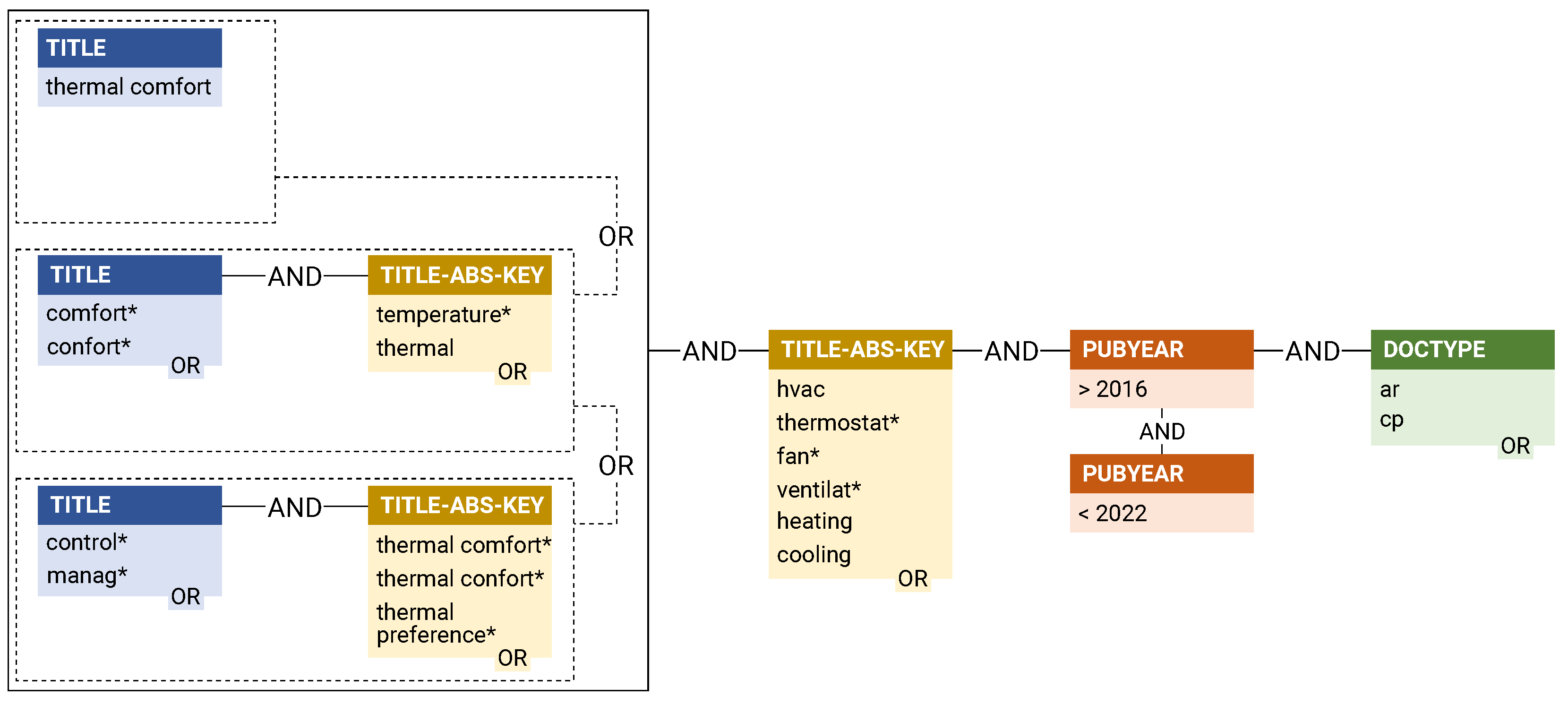

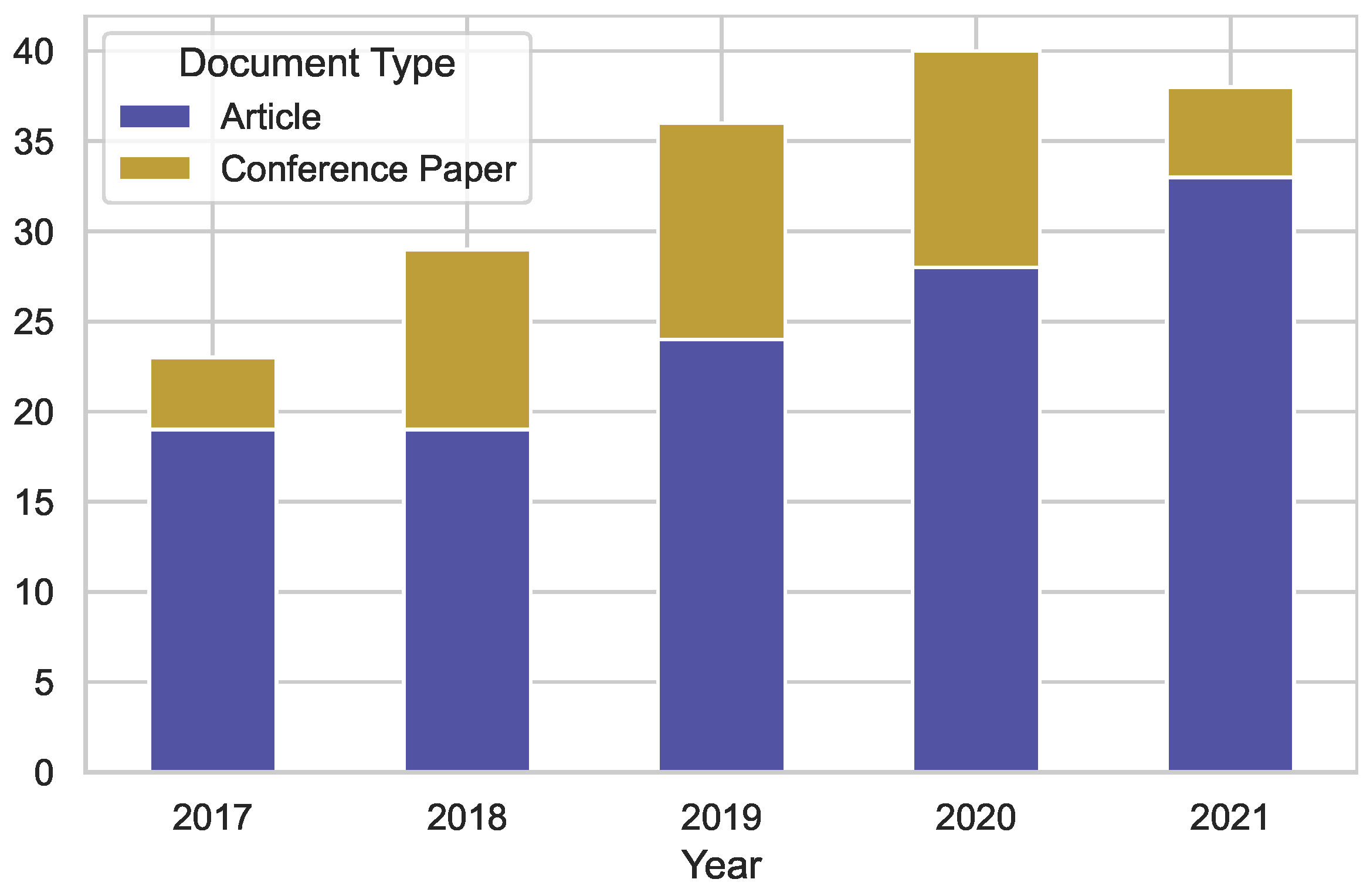


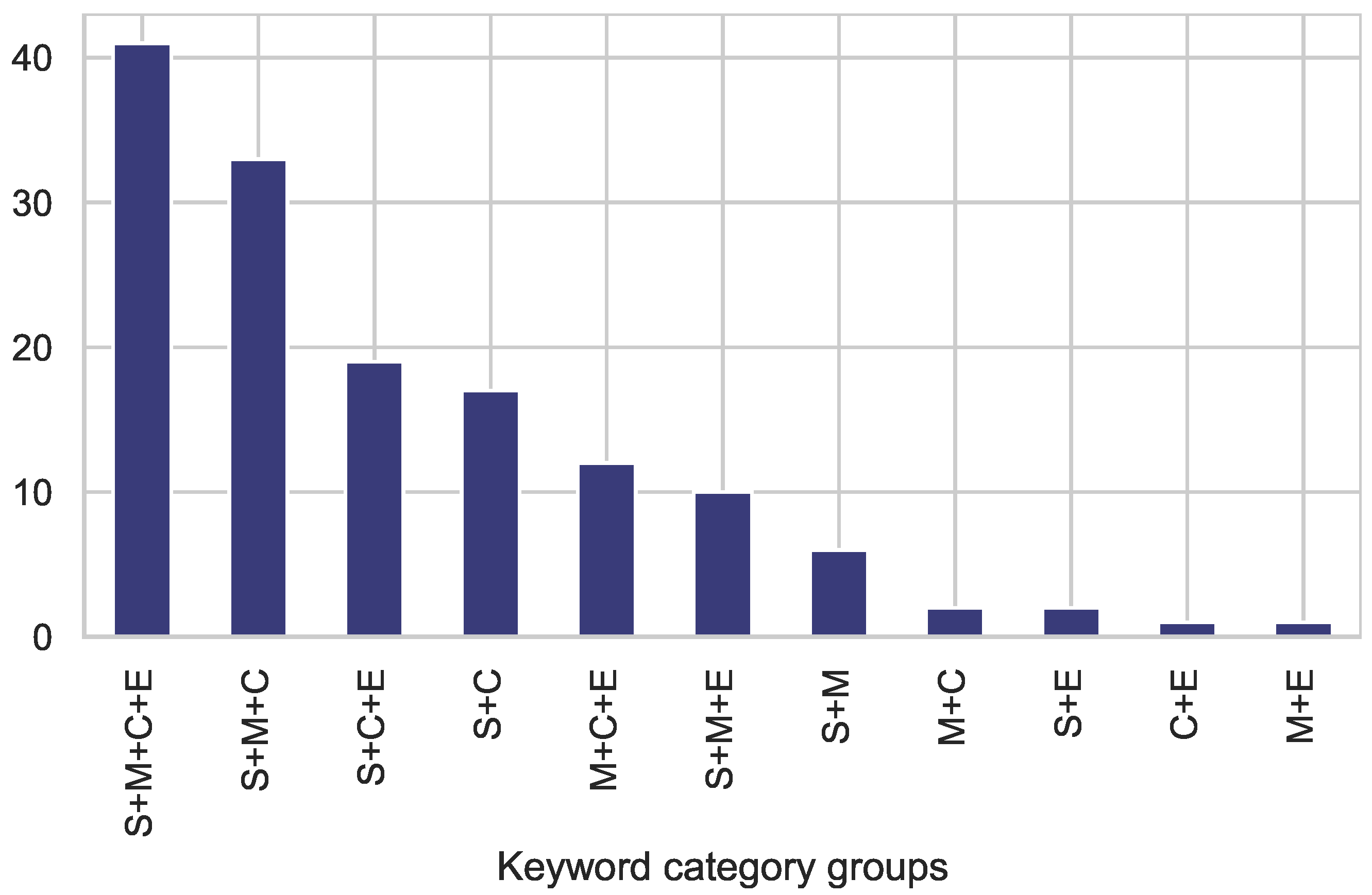
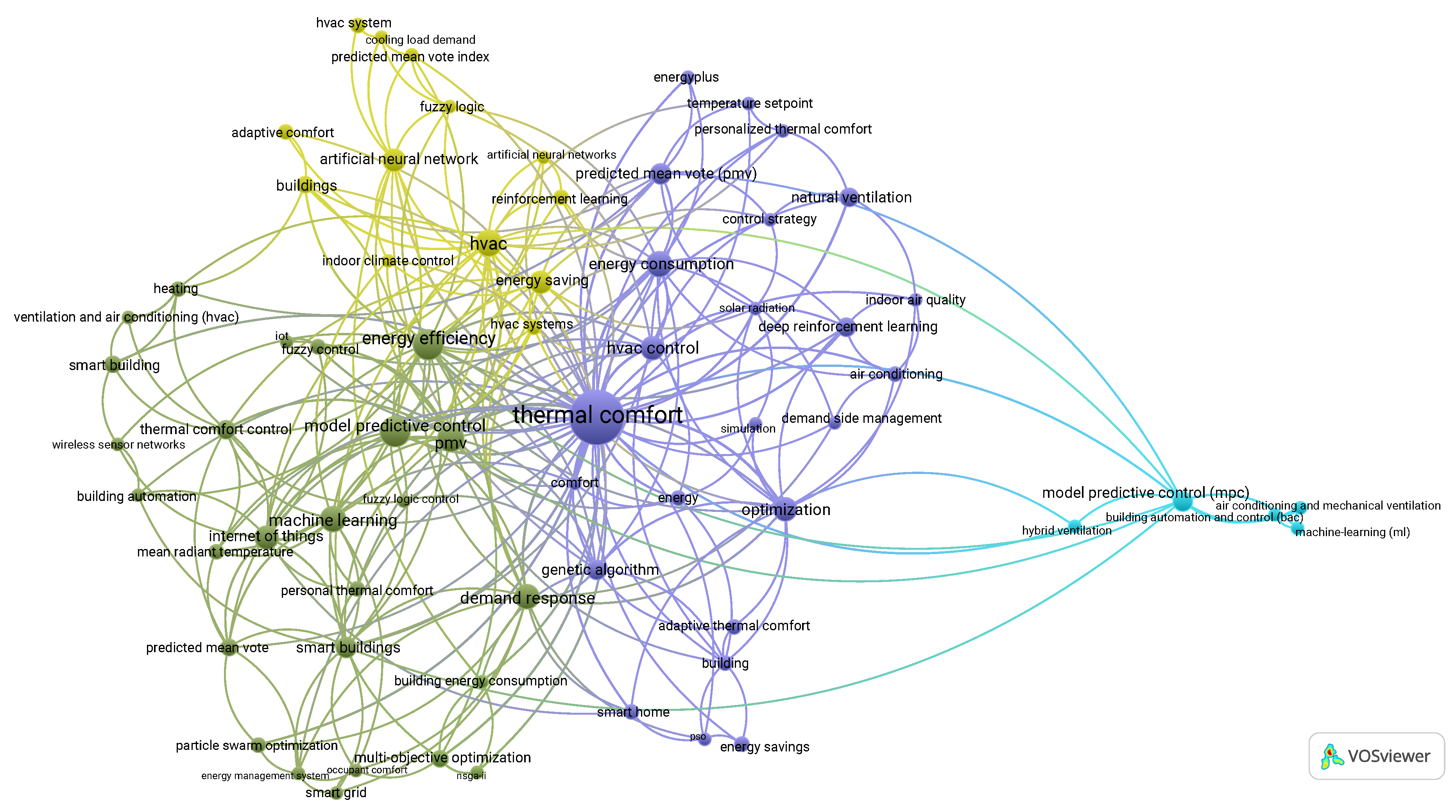
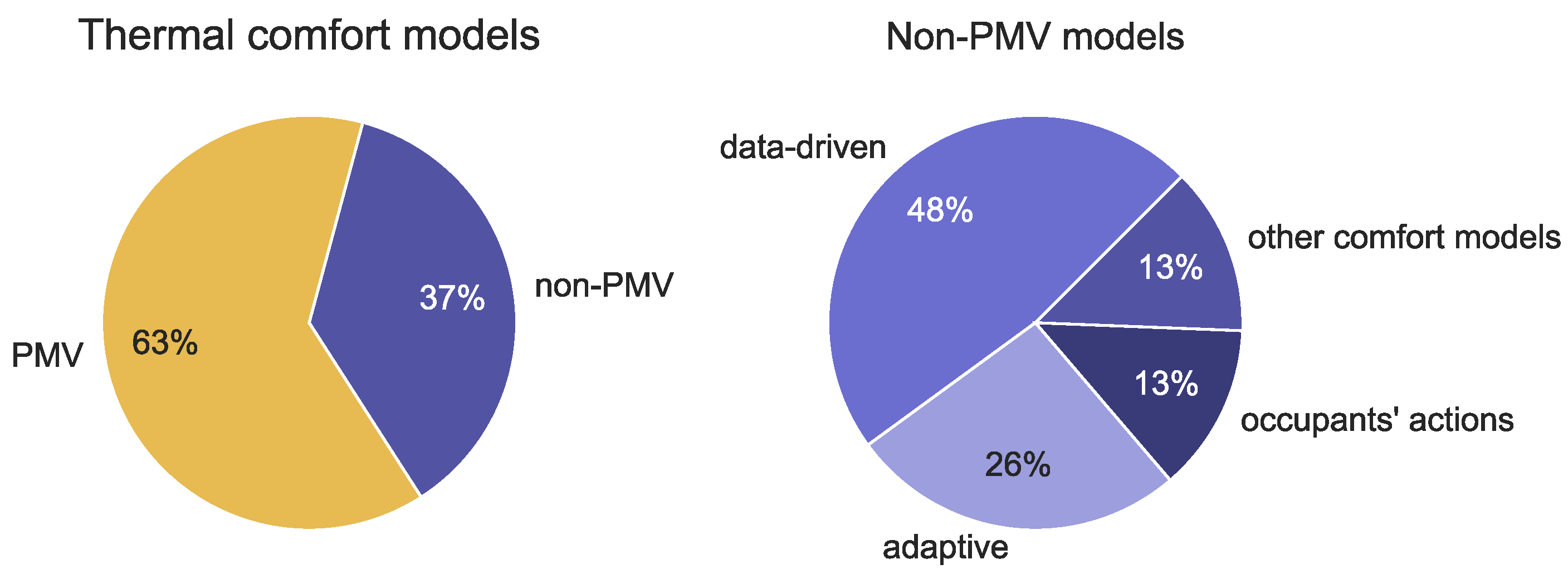
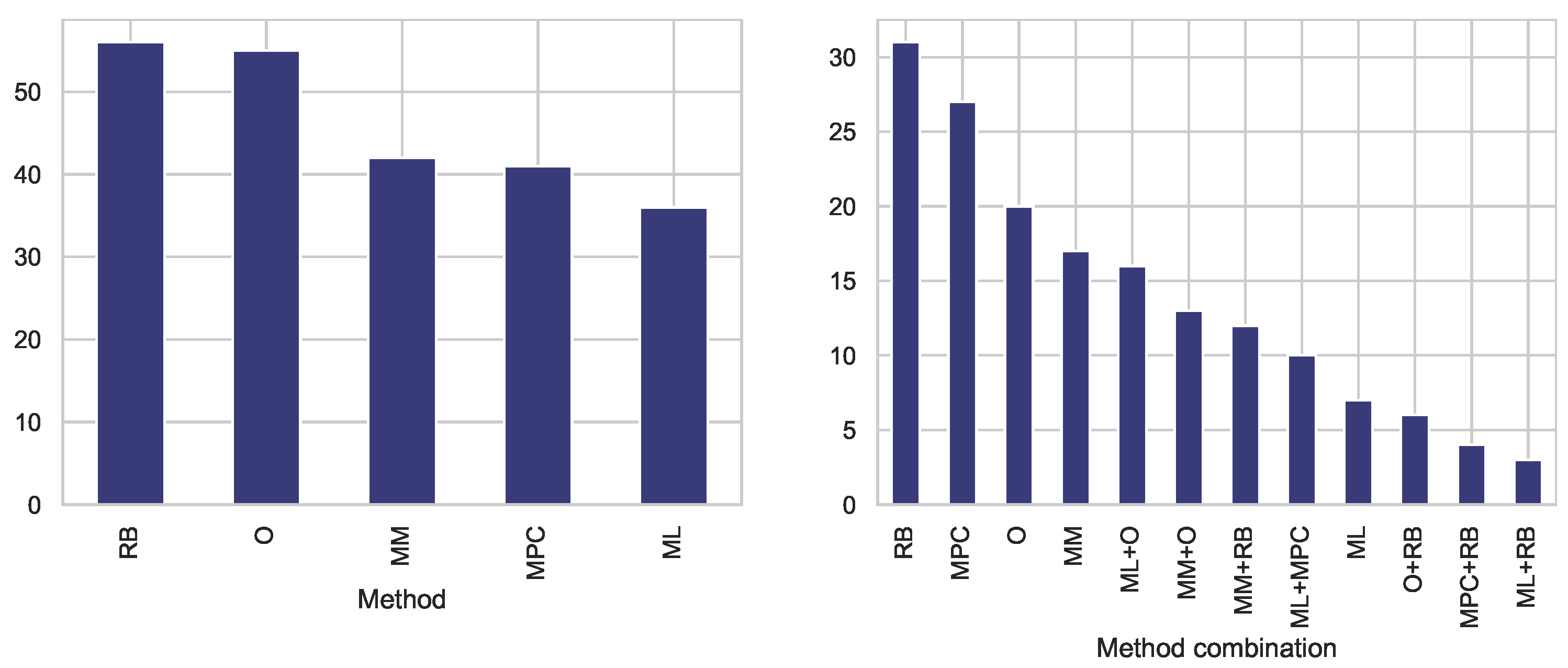
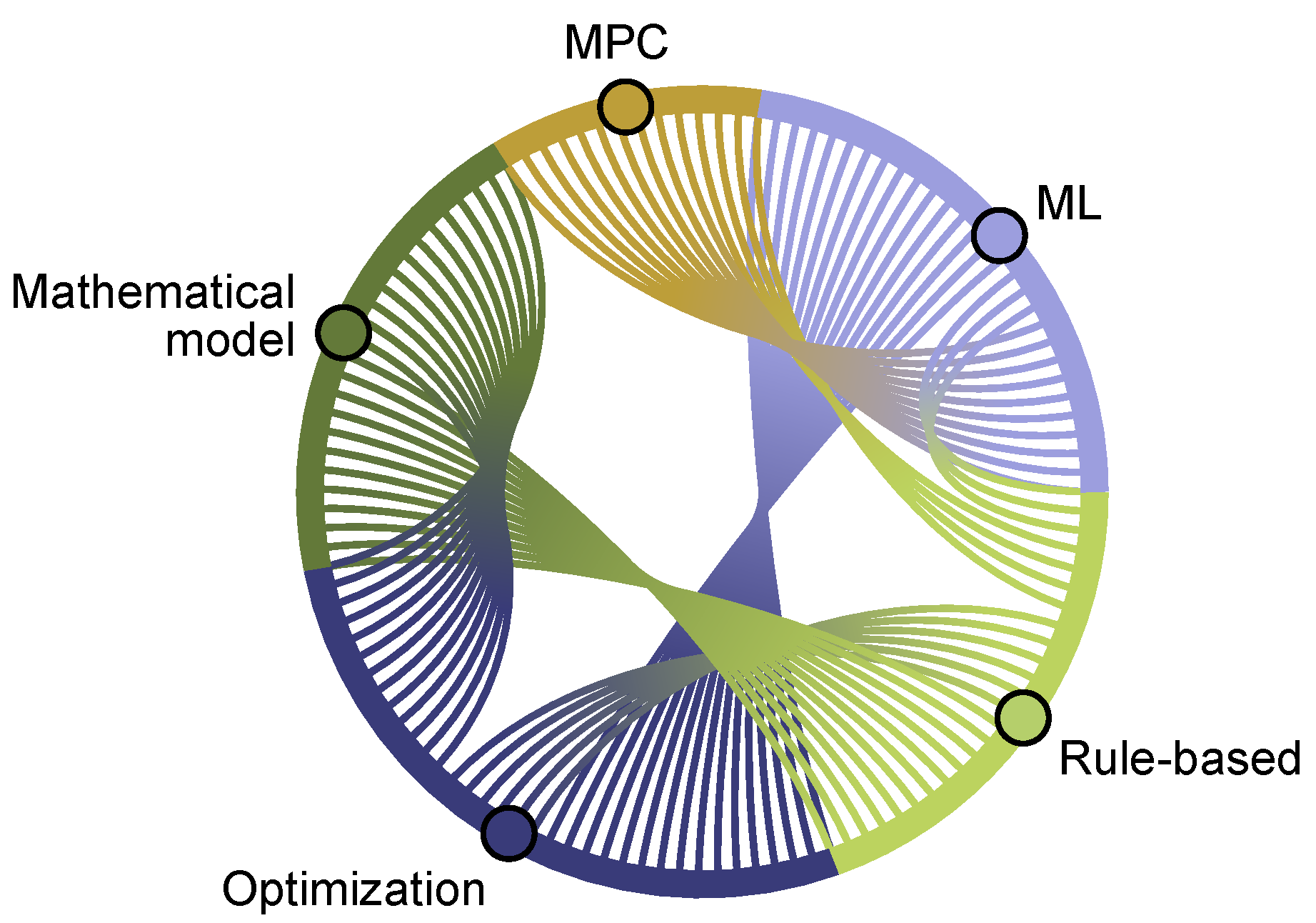
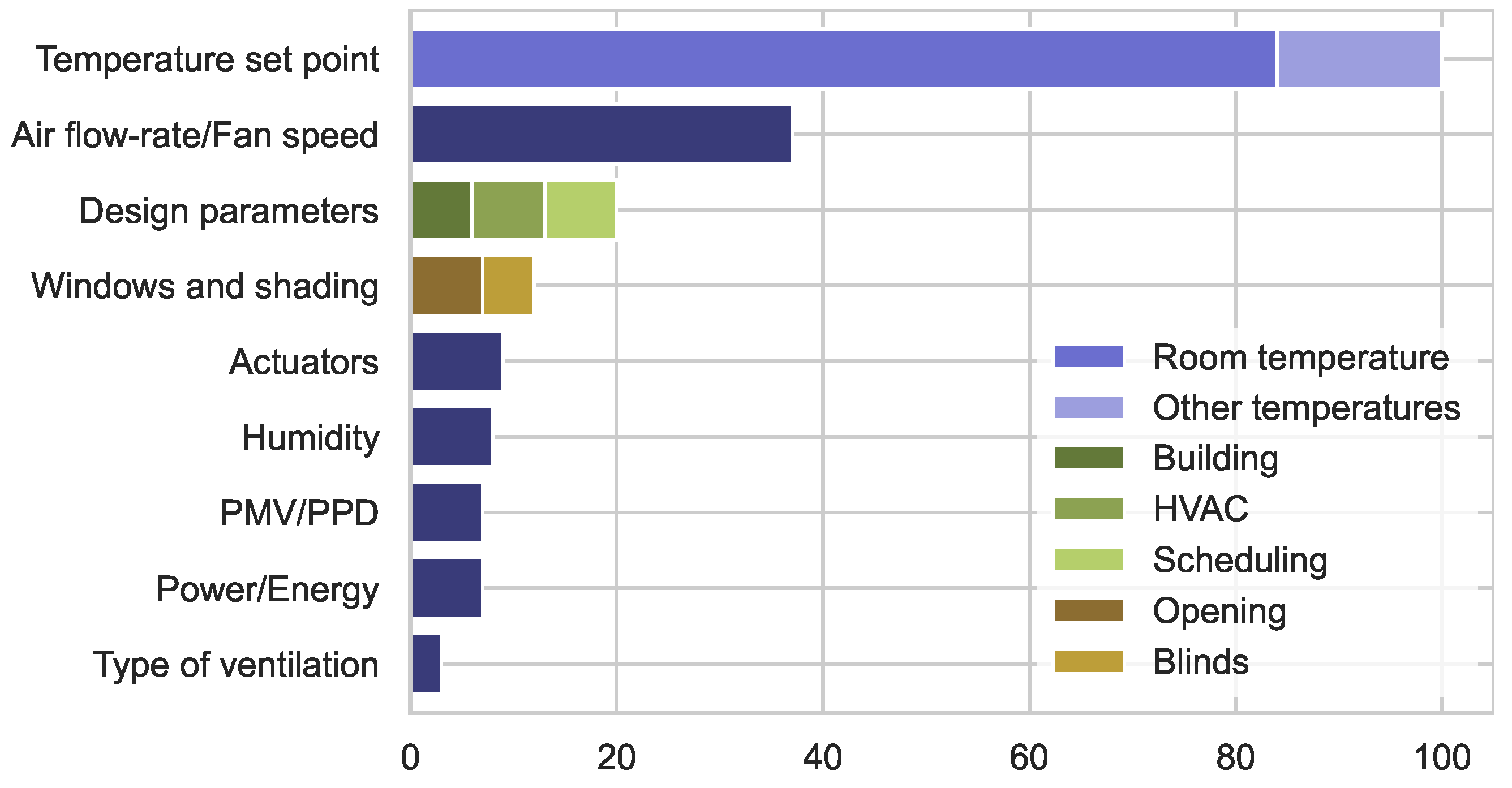
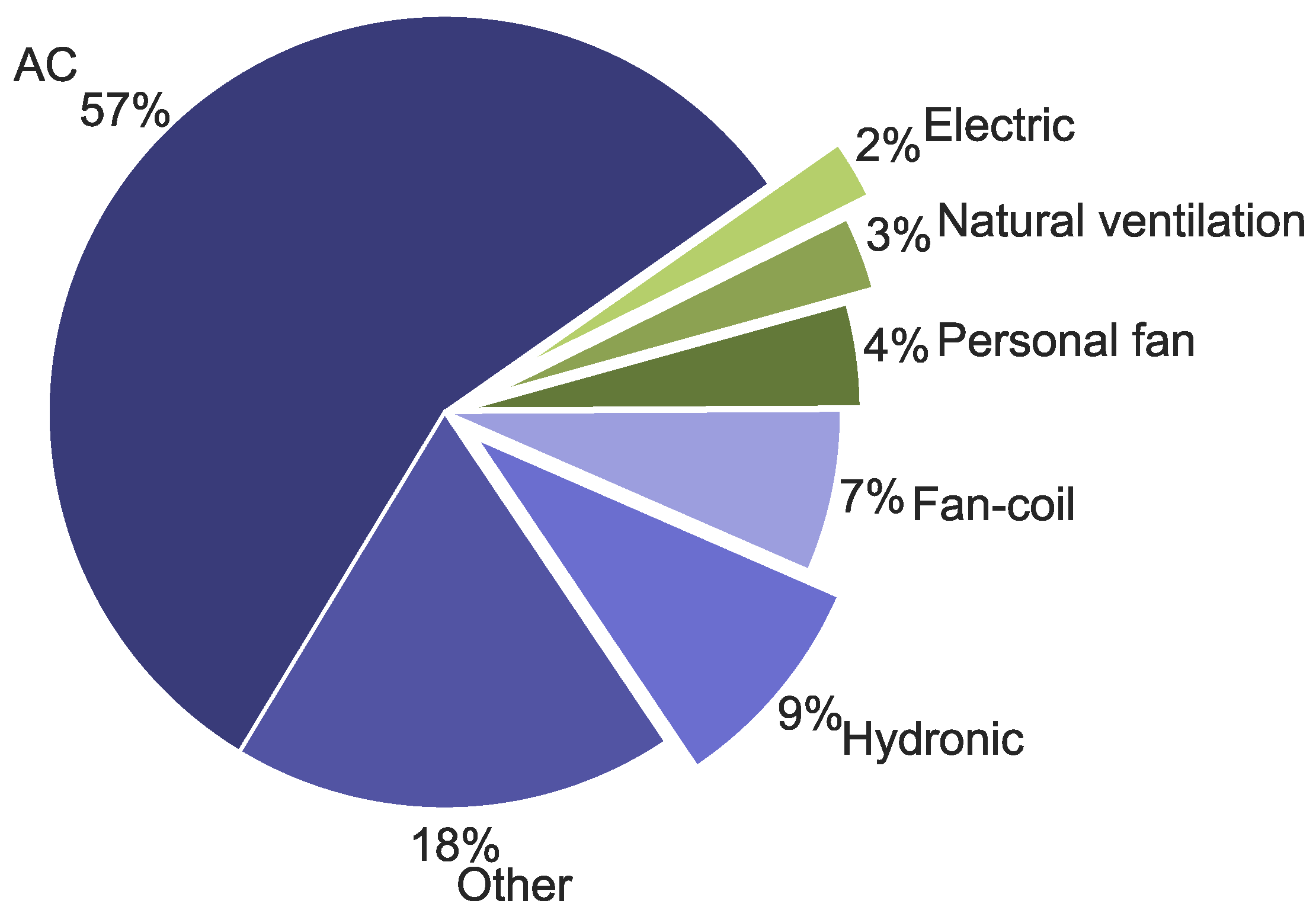
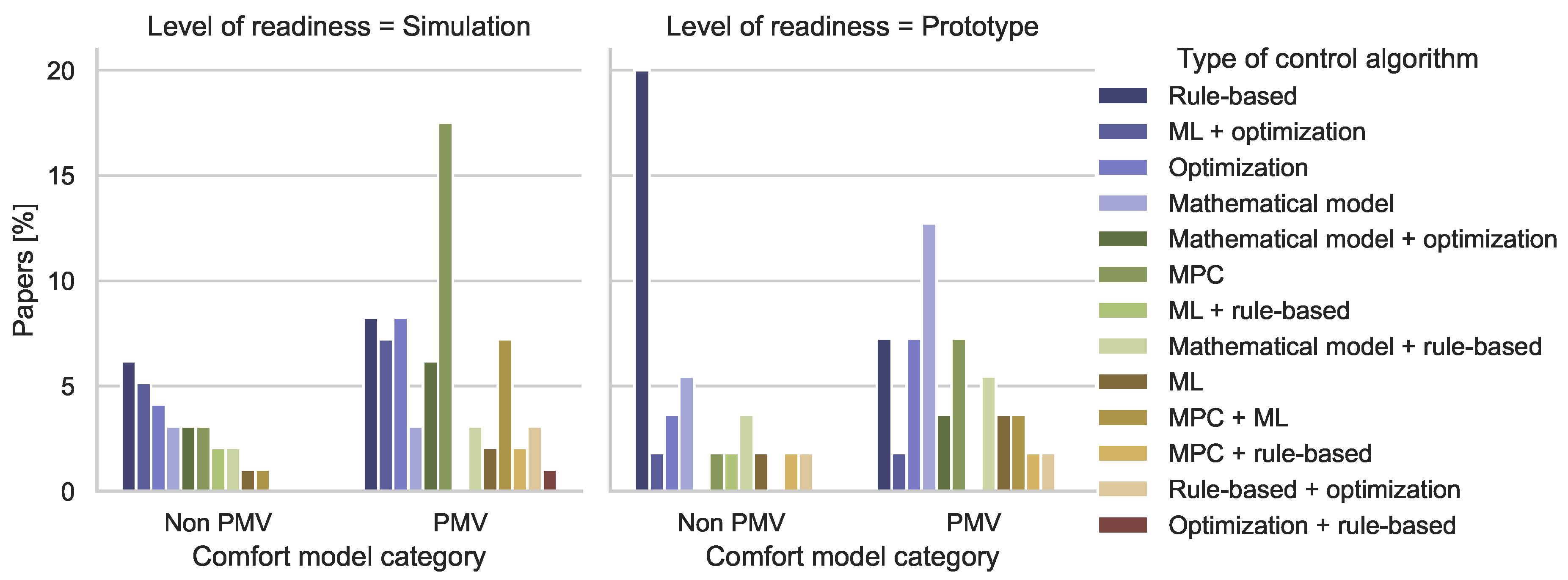


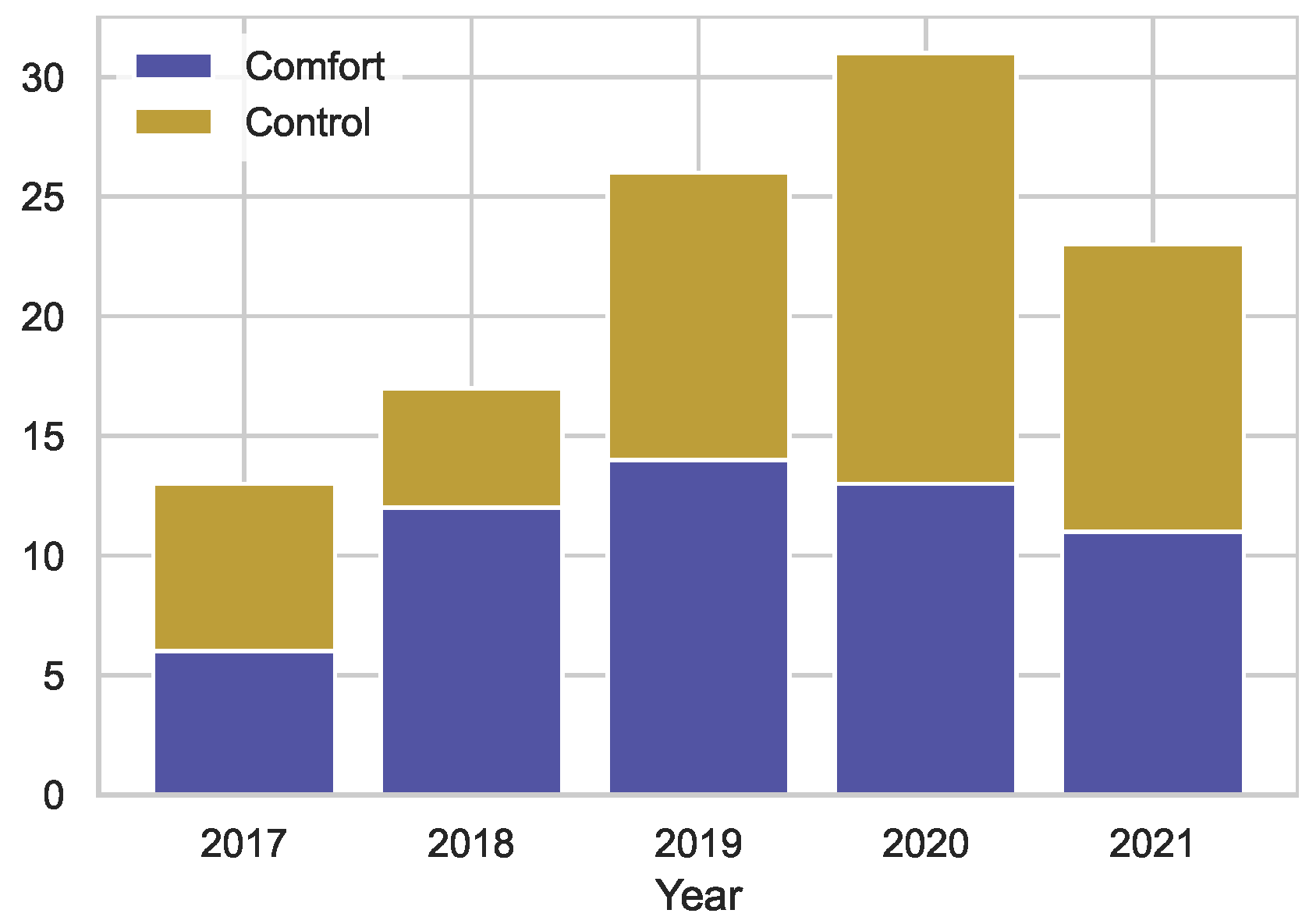
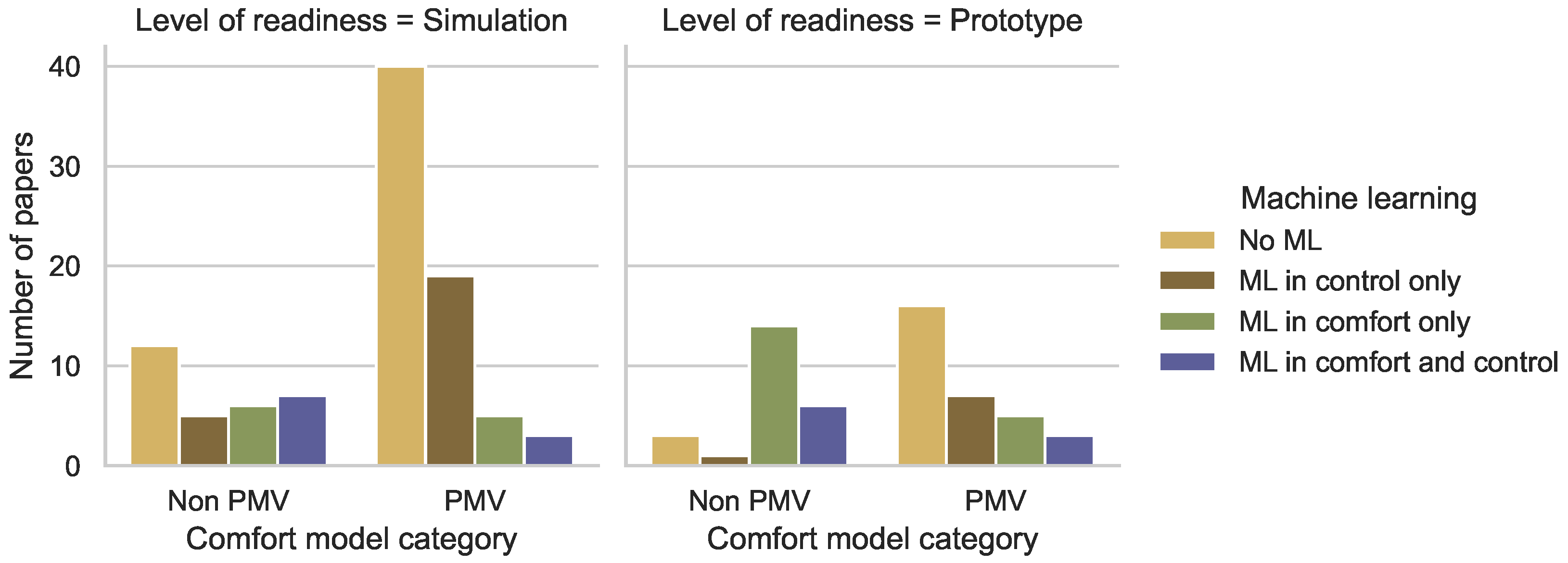
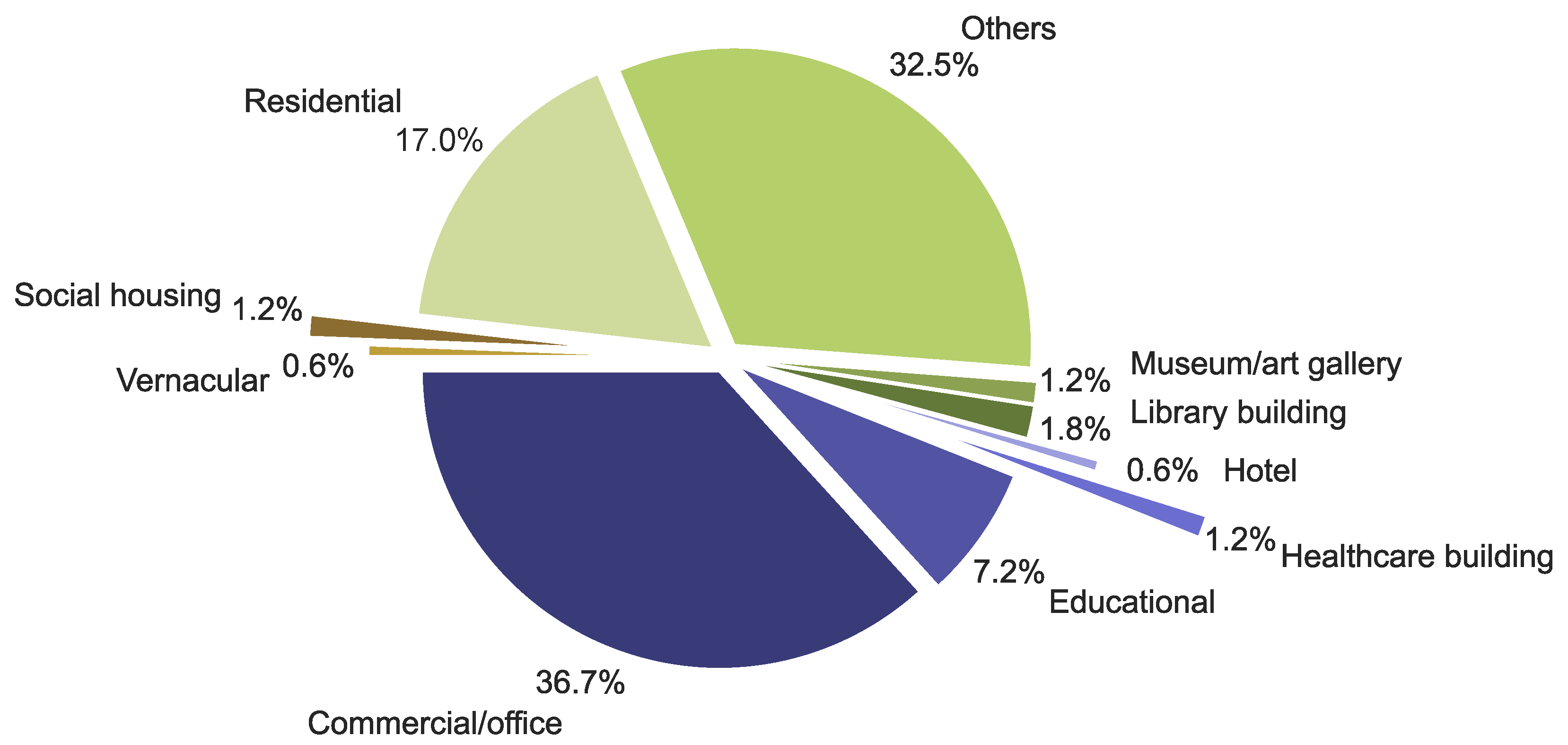
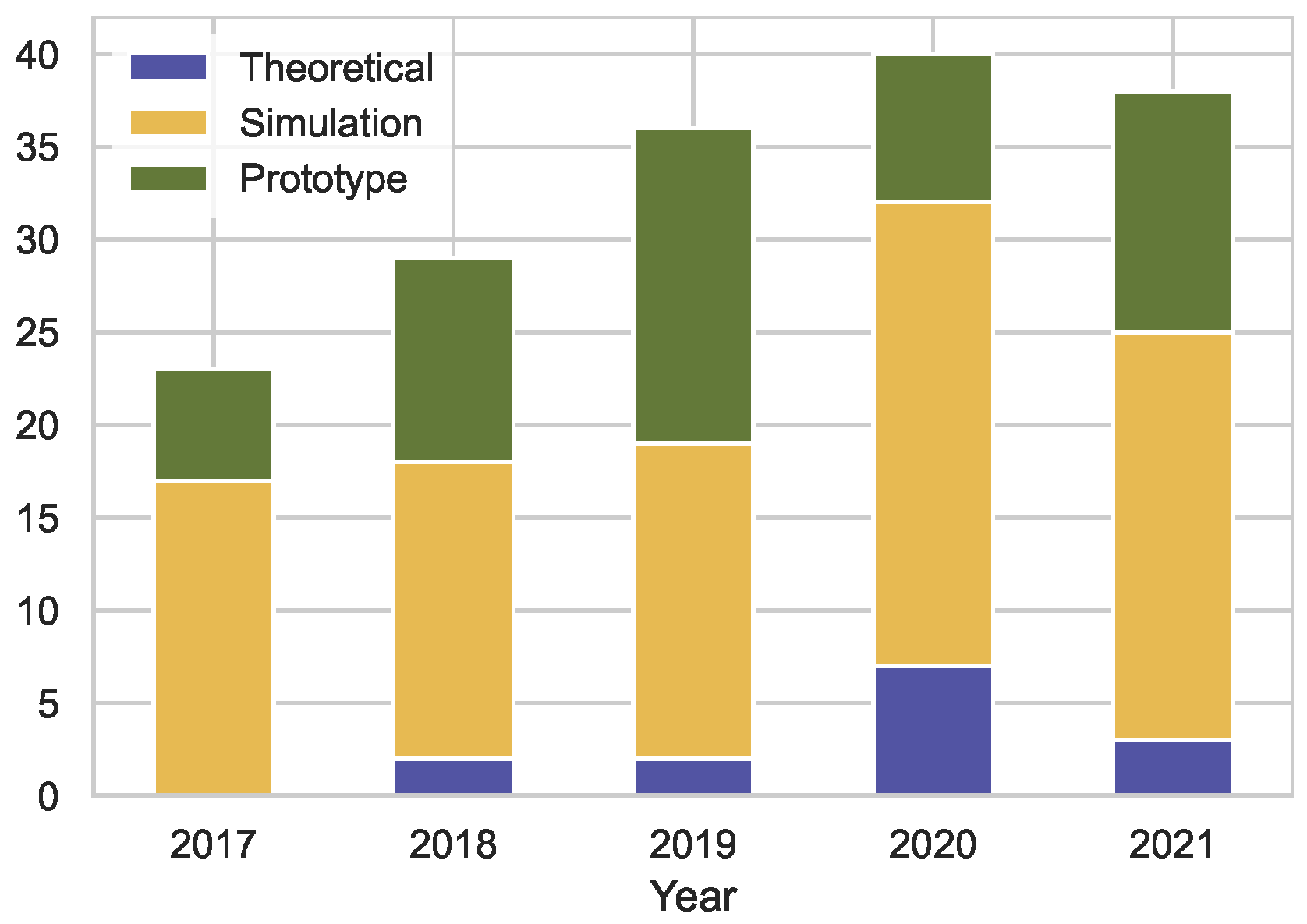

| Selection Stage | Selection Base | Criterion | Process Type | Output | N. |
|---|---|---|---|---|---|
| 1. Scopus search | Search query | Search query in Figure 1 is satisfied | Automatic | Scopus search results | 2472 |
| 2. Preliminary screening | Abstract | The study may contain a TC model and a TC-based control strategy | Manual | Raw .csv file | 244 |
| 3. Database entry definition | Full paper | The study describes a TC model and a TC-based control | Manual | Final .csv file | 166 |
| 4. Inclusion in main paper | Full paper | The study is relevant for the presentation of the results | Manual | Bibliographic entries | 123 |
| N. | Category | Included Keywords | Real Examples |
|---|---|---|---|
| 1 | Comfort (C) | Thermal-comfort related | “thermal comfort”, “PMV”, “thermal preferences” |
| 2 | System (S) | Associated with real components or systems | “HVAC”, IoT”, “thermostat” |
| 3 | Method (M) | Describing algorithms, models, and solution approaches | “genetic algorithm”, “state-space model”, “CFD simulations” |
| 4 | Energy (E) | Energy efficiency, saving, and consumption strategies | “efficient energy use”, “cooling load”, “demand response” |
| 5 | Generic/not relevant | Too generic to be classified or out of scope | “man”, “electric vehicles” |
| Reference | Thermal Comfort Models |
|---|---|
| Menconi et al. (2017) [30] | • PMV |
| • Adaptive | |
| Frǎtean and Dobra (2018) [31] | • PMV |
| • Adaptive | |
| Chaudhuri et al. (2019) [32] | • PMV, extended PMV, adaptive PMV |
| • Predicted thermal state | |
| • Gender-based (male/female) thermal state | |
| • Temporal profile thermal state | |
| Fiorentini et al. (2019) [33] | • PMV |
| • Adaptive |
| Reference | Comfort Model | Input Parameters |
|---|---|---|
| Zhang et al. (2017) [34] | Linear PMV model based on regression analysis of experimental measurements; M = 1 met, = 0.57 clo | Room air temperature; supply air flow rate |
| Hang and Kim (2018) [35] | Linear PMV model based on regression analysis of measured environmental parameters; M = 1.2 met, = 0.5 clo | Indoor air temperature; mean radiant temperature; relative humidity; air velocity |
| Alizadeh and Sadrameli (2018) [36] | Quadratic PMV model based on regression analysis | Fan blade pitch; fan speed; outdoor air temperature; relative humidity |
| Chen et al. (2019) [37] | Linear PMV model by Buratti et al. (2013) [38]; coefficients depending on gender and clothing insulation | Ambient temperature; relative humidity |
| Vallianos et al. (2019) [39] | Adaptive PMV from Yao et al. (2009) [40] | PMV; adaptive coefficient |
| Kalaimani et al. (2020) [41] | Quadratic PMV models for winter ( = 1 clo) and summer ( = 0.5 clo); M = 1.1 met, RH = 50% | Indoor temperature; air velocity |
| Carli et al. (2020) [42] | Linear PMV model from linearization of the original model; M = 1.2 met, = 1 clo | Indoor air temperature; absolute humidity |
| Fang et al. (2020) [43] | Linearized PMV model based on multi-linear regression; M = 1 met, = 1 clo | Indoor air temperature; air velocity |
| Li et al. (2021) [44] | PMV model by Deng et al. (2018) [45]; M = 1 met, = 0.57 clo | Mean room temperature; mean airflow velocity |
| Yang et al. (2021) [46] | Linear PMV model by Yang et al. (2018) [47]; M = 1 met, = 0.57 clo, = 0.136 m/s | Indoor air temperature; mean radiant temperature; absolute humidity |
| Reference | Inputs | Outputs | Algorithm |
|---|---|---|---|
| Hilliard et al. (2017) [62] | Zone air dry-bulb temperature, ambient air temperature and solar radiation | Zone mean radiant temperature | Regression + adjustment based on occupants’ feedback |
| Li et al. (2017) [63] | Metabolic data, environmental measurements, clothing, thermal preference feedback from app | Thermal preference | Classification (random forest) |
| Auffenberg et al. (2017) [28] | Operative temperature and relative humidity | Optimal comfort temperature, vote and user’s thermal sensitivity | Bayesian network |
| Xu et al. (2018) [64] | Current and historical feedback | Personalized thermal comfort profile | Softmax regression |
| Pazhoohesh and Zhang (2018) [65] | Thermal comfort votes and corresponding indoor temperatures | Thermal perception index | Fuzzy classification and fuzzy map |
| Gupta et al. (2018) [66] | User’s thermal comfort preference for various temperatures | Individual discomfort function (simplification: comfort range limits) | Piecewise approximation (simplifications: values provided direclty) |
| Kruusimagi et al. (2018) [67] | Feedback of thermal sensation and corresponding measured indoor air temperature | Neutral temperature | Regression |
| Qiao et al. (2019) [68] | Thermal sensation feedback, indoor temperature | Thermal satisfaction rate function | Linear regression |
| Chaudhuri et al. (2019) [32] | Skin temperature and conductance, clothing, surface body area conductance, oxygen saturation, pulse rate | Thermal state index | Support vector machine, random forest, convolutional neural network |
| Jung and Jazizadeh (2019) [69] | Actual and synthesized thermal votes from the literature | Thermal comfort profile | Stochastic modeling |
| Lu et al. (2019) [70] | Subset of ASHRAE RP-884 dataset | Thermal sensation | K-nearest neighbors, support vector machine, random forest |
| Aguilera et al. (2019) [71] | Thermal preference vote feedback and corresponding indoor temperature | Thermal preference profile | Fuzzy logic |
| Lee et al. (2019) [72] | Subset of ASHRAE RP-884 dataset + assumptions on metabolic rate, clothing insulation and air velocity | Thermal preference | Bayesian clustering; online classification |
| Reference | Inputs | Outputs | Algorithm |
|---|---|---|---|
| Gao et al. (2020) [73] | Indoor temperature and humidity | Thermal comfort value | Feedforward neural network |
| Mohamadi and Ahmed (2020) [74] | Personal factors and indoor environmental parameters | Comfort coefficient | Neural network |
| Alsaleem et al. (2020) [75] | Biometric data, environmental data, comfort feedback | Thermal comfort level | Decision tree, adaptive boosting, gradient boosting classifier, random forest, support vector machine |
| Kumar Yadav et al. (2020) [76] | Preferred temperature via app | Individual temperature preference | Value provided directly |
| Deng and Chen (2020) [77] | Thermal sensation feedback and environmental measurements and physiological parameters | Thermal sensation | Artificial neural network |
| Li et al. (2021) [78] | Thermal sensation and thermal satisfaction feedback, heart rate, and wrist skin temperature and its variation | Thermal sensation | Linear regression |
| Aryal et al. (2021) [79] | Thermal comfort feedback, environmental indoor and outdoor mreasurements, clothing level, HVAC equipment states | Thermal sensation and thermal satisfaction | Random forests, k-nearest neighbors |
| Li and Chen (2021) [44] | Classified garment image database; thermal sensation vote feedback, air and face temperature | Clothing level classification, comfortable air temperature | Convolutional neural network |
| Reference | Preference-Related Actions | Model Development |
|---|---|---|
| Yano (2018) [104] | Set-point temperature operating time | Statistical model to define acceptable set-point temperatures based on their operating (unchanged) time |
| Marche and Nitti (2019) [105] | Interactions with HVAC comprehensive smartphone app | Thermal profile for each user with Gaussian function based on previous actions |
| Shetty et al. (2019) [106] | Personal fan operation (on/off and speed setting) | Classification and regression algorithms to predict on/off state and preferred air speed in case of “on” state |
| Cicirelli et al. (2020) [107] | User’s interactions with HVAC system (e.g., the user turns on the heating) | Deep reinforcement learning with penalty given each time the user operates on the HVAC switch |
| Chenaru and Popescu (2020) [108] | Corrective actions (e.g., local temperature adjustment) | Relevant actions incorporated in learning phase to train comfort model |
| Amasyali and El-Gohary (2021) [109] | Thermostat adjustment, operation of doors and shading devices | Classification algorithm to develop group and individual models from action recordings |
| Zhu et al. (2021) [110] | Air-conditioning switching on/off and set-point adjusting | Classification rules returning preference patterns for the specific action (on/off or set-point) |
| Laftchiev et al. (2021) [82] | Temperature set-point adjustment | Endpoints of default comfort temperature range shifted to current temperature based on change direction |
| Reference | HVAC | H/C | Control Variables | Building | Control |
|---|---|---|---|---|---|
| Wu et al. (2021) [154] | Chilled beams | C | Chilled water flow rate, room temperature set-point | Any | MM + O |
| Xu et al. (2020) [155] | Radiant system | H | Room temperature set-point | Any | MPC |
| Hawila et al. (2018) [59] | Radiators | H | Indoor air set-point temperature | Any | MM |
| Potočnik et al. (2018) [136] | Radiant system | H | Optimized heating curve for heat pump flow temperature | Residential | MPC |
| Hong et al. (2018) [60] | Radiant system | Any | PMV | Residential | MM |
| Uguz and Ipek (2017) [131] | Radiators | H | Radiator valve position | Any | MM |
| Lin et al. (2021) [98] | Radiant system | H | Heating/cooling device status | Any | MM |
| Karatzoglou et al. (2018) [156] | Radiators | H | Thermostat set-point | Any | MM + O |
| Yang et al. (2021) [132] | Chilled beams | C | Pump speed; valve opening | Office | MPC + RB |
| Ke et al. (2020) [157] | Radiators | Any | Indoor temperature | Any | MPC + ML |
| Ascione et al. (2019) [158] | Baseboard radiators | H | Hourly room set-point temperatures in typical days | Residential | MPC |
| Aguilera et al. (2019) [71] | Radiators | H | Room temperature set-point | Office | O |
| Lee et al. (2019) [72] | Radiant system | C | State of radiant coil valves | Office | MPC |
| Zhang and Lam (2018) [123] | Radiant system | Any | Supply water set-point | Office | ML + O |
| Yano (2018) [104] | Radiators | H | Thermostat set-point | Residential | RB |
| Reference | Decision Approach | Building | Comfort |
|---|---|---|---|
| Li et al. (2017) [63] | Collective decision algorithm aiming to satisfy at least half of the occupants | Any | Data-driven |
| Auffenberg et al. (2017) [28] | Comfort compromiser algorithm taking the maximum of the lower bounds and the minimum of the upper bounds of occupants’ ranges | Any | Data-driven |
| Xu et al. (2018) [64] | Aggregated profiles of multiple occupants | Office | Data-driven |
| Liu et al. (2018) [125] | Cooperative approach: worst-case deviation from set-point minimized | Educational | PMV |
| Gupta et al. (2018) [66] | Minimization of total discomfort from zone occupants’ profiles | Any | Data-driven |
| Laing and Kühl (2018) [147] | Compatibility between personal preference and zone characteristics | Commercial | Data-driven |
| Yang et al. (2019) [160] | Minimization of total PPD or largest PPD among communities | Not discussed | PMV |
| Aguilera et al. (2019) [71] | Minimization of group thermal discomfort | Office | Data-driven |
| Lou et al. (2020) [57] | Worst-case PMV of occupants in different positions | Residential | PMV |
| Anasyali and El-Gohary (2021) [109] | Group and individual comfort models | Office | Occupants’actions |
| Zhang et al. (2021) [130] | Occupancy-weighted average of multiple occupants’ thermal comfort | Commercial | PMV |
Publisher’s Note: MDPI stays neutral with regard to jurisdictional claims in published maps and institutional affiliations. |
© 2022 by the authors. Licensee MDPI, Basel, Switzerland. This article is an open access article distributed under the terms and conditions of the Creative Commons Attribution (CC BY) license (https://creativecommons.org/licenses/by/4.0/).
Share and Cite
Grassi, B.; Piana, E.A.; Lezzi, A.M.; Pilotelli, M. A Review of Recent Literature on Systems and Methods for the Control of Thermal Comfort in Buildings. Appl. Sci. 2022, 12, 5473. https://doi.org/10.3390/app12115473
Grassi B, Piana EA, Lezzi AM, Pilotelli M. A Review of Recent Literature on Systems and Methods for the Control of Thermal Comfort in Buildings. Applied Sciences. 2022; 12(11):5473. https://doi.org/10.3390/app12115473
Chicago/Turabian StyleGrassi, Benedetta, Edoardo Alessio Piana, Adriano Maria Lezzi, and Mariagrazia Pilotelli. 2022. "A Review of Recent Literature on Systems and Methods for the Control of Thermal Comfort in Buildings" Applied Sciences 12, no. 11: 5473. https://doi.org/10.3390/app12115473
APA StyleGrassi, B., Piana, E. A., Lezzi, A. M., & Pilotelli, M. (2022). A Review of Recent Literature on Systems and Methods for the Control of Thermal Comfort in Buildings. Applied Sciences, 12(11), 5473. https://doi.org/10.3390/app12115473








